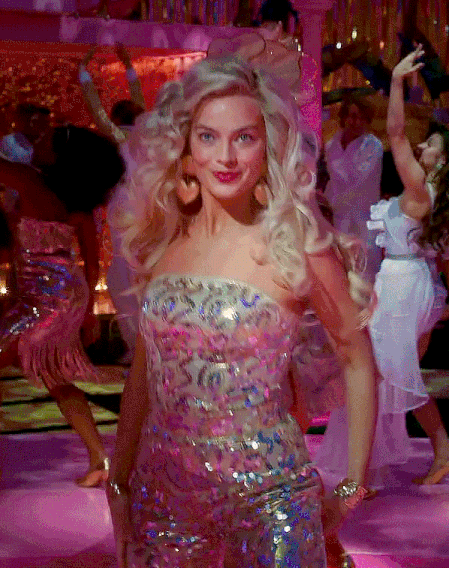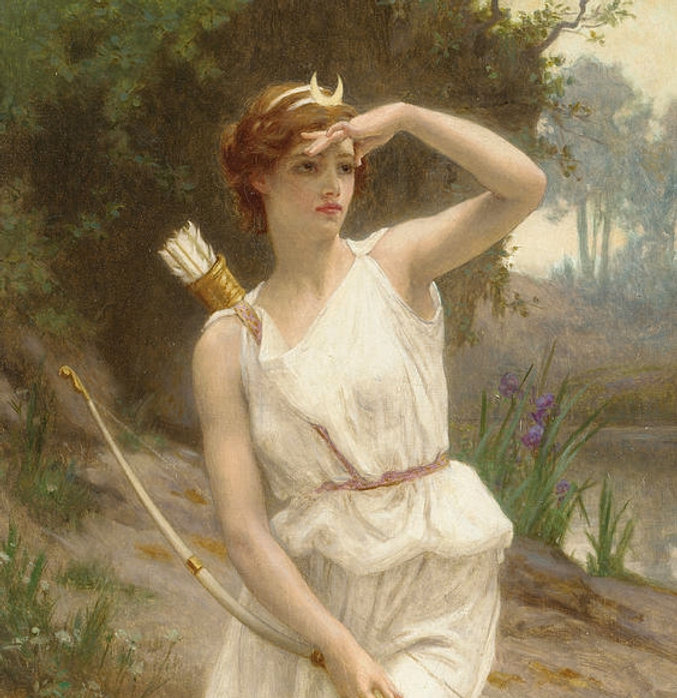-
Reflections on Beltane: The Goddess of Sovereignty & Feminine Power

It is the first day of May, and for the first time this year, we’ve had our first *properly* warm weather in my neck of the woods. Couldn’t be more fitting.
It’s the time of year where you look out the window and see bird couples cosying up to each other like a newlywed couple on their honeymoon. Despite the start of winter being labelled ‘cuffing season’ where people try to couple up to seek companionship and warmth in the cold months, it is this time of the year that is most aligned with romantic love and sexuality. Traditionally, young couples would go into the woods together on May Eve to make love and come back with flowers.
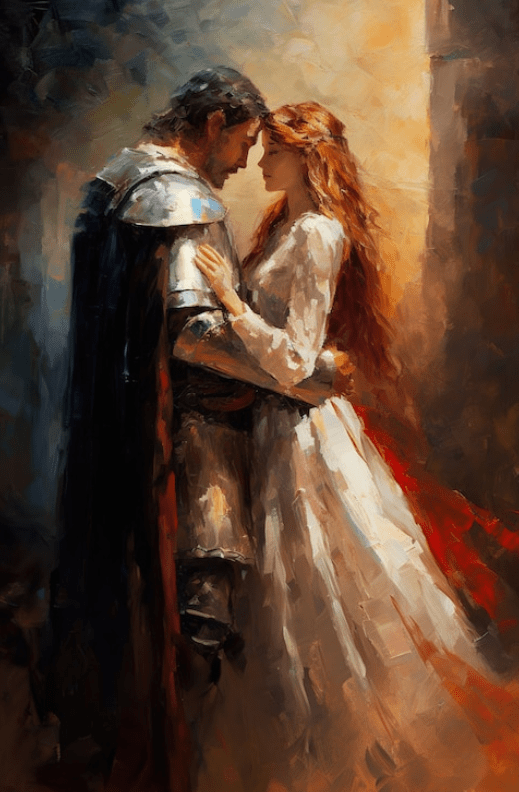
Art Credit In some of the modern pagan religions who take their inspiration from ancestral Celtic myth and lore, this is the time we acknowledge the marriage of the Sovereignty Goddess, Goddess in the aspect of Lover-Queen, and the divinely anointed King. The Goddess chooses the King who is right for the land, making him Her chosen Lover, Champion and Protector. He is an absolutely necessary part in fulfilling and executing Her visions. To quote Caitlín Matthews in her illuminating Mabinogi companion King Arthur & the Goddess of the Land:
The king’s union with the land, the Goddess of Sovereignty, is a very special one characterised by an exchange of energies and powers: the king swears to uphold his land and people and to be true to them, while Sovereignty gives him otherwordly gifts enabling him to keep his oath. At its base, the Celtic concept of Sovereignty is related to the Middle Eastern concept of wisdom as Sophia, who consorts with kings as the creative and wisdom-bestowing mystic woman appearing in the form of either an angelic presence or an earthly woman. Solomon and Sheba are the prime example of this king-Sophia paradigm. In British symbolism, Arthur and one of Sovereignty’s representatives, such as Gwenhwyfar, exemplify the similar king’s paradigm.
This dynamic is hotly debated. I have read some hardcore reconstructionists and feminists alike caution against romanticising it too much as they believe it is nothing more than a patriarchal construct in which patriarchal monarchy is validated through claiming the Goddess gives them the right to do so. And sure, we can’t know for sure that it wasn’t that, but we can’t know for sure that it was, either. To me, this seems very obviously an example of a time where patriarchal civilisation/order cracks and underlays the matriarchal, dare I say gynocentric foundations it is based upon. The masculine may rule in the outer realms, with our society being patriarchal for much of history, but the feminine rules the inner realms. In fact, many Celtic tribes were matrilineal, and while it was men who were the regnant rulers, the right to rule, the literal ‘divine right of kings’, was passed through the female line, meaning the king’s nephew through his sister, not his son, would inherit the crown (which potentially is what the struggle between Arthur and Mordred is referencing). To quote Caitlín Matthews once again from the same book:
Sovereignty is not merely a passive archetype, some kind of negative cypher whose sole purpose is to empower kings and heroes. As a goddess and through her human representatives she exists in her own right and actively promotes, obstructs, or dismisses her chosen candidates. She and her elect continually modify and develop their relationship; as the essential quality of the land personified, Sovereignty has the right to change her mind and frequently does so. Even Arthur himself is not exempt from her strictures.
And…
Throughout the course of our study of the relationship between Sovereignty and her champion, we note that the Goddess is not submissive, mild and biddable; rather, she is a powerful force armed with subtle skills and deep wisdom.
I’ve talked the ear off anyone who will listen to me ramble about this topic but there has been an obsession in the new age spirituality community (and its branch-off- the polarity dating coach scene) for a while to exalt ‘feminine submission’ and to push the narrative that the true ‘nature of the divine feminine’ is to submit to a powerful man. I’m aware that some people’s definition of ‘submission’ is different from my own, but following the dictionary definition, that term does not refer to most divine feminine figures I am aware of. New age spirituality is often just evangelical Christianity cosplaying as paganism or esoterica and I’m getting quite sick of it. It’s no reason why so many of them end up reverting back to Christianity (which I have no problem with in and of itself) and immediately start denouncing their previous path as demonic and evil. There is a very clear pipeline, and the misogyny found in both movements is very much the same. Whether this has been a feature of the new age movement from the beginning or has been a subtle takeover from the ‘alpha male’ dating coach bros, I don’t know, but I’m tempted to say it’s a combination of both, perhaps. But ‘divine feminine’ does NOT mean ‘divinely ordained Abrahamic patriarchal gender roles’, it means the power of the Goddess, that lives in everyone and everything, but women are the most direct embodiment of Her power on earth. We ourselves are not goddesses (Caitlín has recently written about this on her Substack– I highly recommend subscribing or grabbing the free trial so you can read it and its follow-up posts yourself) but we certainly are Her hands upon the earth, and if the Goddess herself is not submissive, why would we be? Certainly there is a time and a place to let the man lead, make decisions, etc. Many women in the modern day feel burned out. Women are overtaking men in many areas of public life, but as a result of this they feel burned out and exhausted. Many feel the need to compete with men in the workforce to ‘prove’ they can ‘do everything a man can’- and that’s no good either. Your work ethic should come from you, not some desire to prove a point and it should not come at the expense of your emotional, mental, physical and spiritual wellbeing. Furthermore, many women in the dating scene, myself included, have expressed frustration with male passivity at the moment. Men are too frightened to initiate anything with women they’re attracted to and refuse to lead in anything. Just look at the comments in any video of Travis Kelce and Taylor Swift interacting to see how much many women, even feminist/liberal ones, find it attractive when a man is able to lead, be protective and masculine. But this doesn’t make every women at the receiving end of this inherently ‘submissive’. She leads in her own way, through setting the emotional, sexual and romantic tone of the relationship. Through being the divine power source of the masculine. She plays the role of the Sovereignty Goddess. She is leading in the subtle, divine realms.
I have seen it said that the role of femininity is to support, amplify and nurture the masculine’s vision and power, but as a Goddess-worshipping Celtic pagan I can’t help but laugh at this because whilst it may be true in the sense of traditional relationship structures, it is ignoring that this is mirrored in the spiritual realms in many pagan traditions where the role of the masculine is to support, protect and execute the visions and power of the feminine. It really depends on which angle you’re approaching it from and in which sense you’re actually talking about.
That’s not to say there aren’t times when the Goddess appears passive and submissive in these stories, but it is usually against Her will. In the fourth branch of the Mabinogion, Blodeuedd is created as the perfect, biddable, pliable, submissive wife for Lleu Llaw Gyffes. It is not until Lleu is away and she falls in love with the hunter Gronw Pebyr that she breaks free from this spell, initiated into decisive feminine sexuality that allows her to choose who she’ll love- and she chooses Gronw. Some pagan scholars have interpreted this as a seasonal allegory. The Sovereignty Goddess switches between a King representing Summer/Order/Light and a King representing Winter/Chaos/Darkness in order to hold the seasons in balance. I have talked about this here this time last year. There is a misinterpretation that the Winter King/Summer King narrative was invented by Robert Graves, but he only created a modern framework for a very old pattern in Celtic mythology. We see this same thing with Creiddylad as she is kidnapped by Gwyn Ap Nudd when she is due to be wed with Gwythyr. Gwenhwyfar, also, in many early Arthurian stories, is abducted by men in a similar fashion. Interestingly enough, with both of these stories there have been interpretations that these ‘abductions’ are actually rescue missions- the man that represents the Otherworld rescuing an Otherworldly faerie woman from her Christian captors and taking her back home. When the French got a hold of Arthuriana, they create Lancelot, and the abduction becomes a consensual love story. Lancelot is associated with the Lady of the Lake, and thus represents the Otherwordly Champion aspect of the divine masculine to Arthur’s Solar Hero.
Other goddesses/figures I consider to embody this Sovereignty Goddess (both in the Celtic tradition and otherwise) archetype are:
- Olwen
- Elen Luyddog
- Rhiannon
- Modron
- Morgan le Fay
- Elaine of Corbenic
- Macha
- Áine
- Isolde
- Mary Magdalene
- Sophia
- Inanna
- Helen of Troy
- Isis
And many more.
I am currently reading a book on Courtly Love- a medieval literary genre that influenced gender roles in the medieval court. Because of courtly love, women went from being seen as temptresses and the embodiment of evil, to the driving force behind all great masculine action, mediatrixes between God and man, embodiments of Venus, and yes, the Sovereignty Goddess. Women hold the Power of Love, which transforms and initiates the masculine, as seen in the Heroes Journey. After all, what does a man getting on one knee to propose represent if not this? This ontology throws a wrench in the submissive woman and ancillary femininity paradigm. In this dynamic, the feminine is the centre, the masculine is the protective rim that moves around her. I’ve talked about similar ideas to this in other posts. My path is extremely Goddess focused, but that does not mean I reject divine masculinity. Without the direction and executive powers of the masculine, the raw creative power of the Goddess would have nowhere to go. He carries out Her mission. In spiritual matters, the divine feminine leads, and so my spiritual path is divine feminine focused. In the physical, every day realm, I want a man who can step into his divine masculinity to lead in the physical. It’s not inaccurate to say neither of us are submitting to the other but actually I’d say we both are submitting to each other. And, of course, even if we are more feminine or more masculine we should each seek to integrate our animus/anima and incorporate aspects of both in order to lead the most fulfilled lives and not rely entirely on the opposite sex to embody all of the other traits for us (still working on this myself).
Ultimately, for me, Beltane is a celebration of all of this, and the most important festival in my personal observation of the Wheel of the Year. For most pagans it seems to be Samhain, for me it’s Beltane. I named my blog Idylls of the Queen for a reason, a play on Tennyson’s Idylls of the King. There is a whole feminine realm to Arthuriana that has gone over a lot of people’s heads until very recently, thanks to the work of the Matthews’, Dion Fortune, pioneers of the Avalonian branch of the Goddess movement, and many others, and much of it concerns this idea of the divine feminine as the true power driving the events of the stories: NOT the Christian god. In order to acknowledge divine feminine power, we need to look beyond the material, the exoteric, the obvious. We need to pull back the veil, go beneath the surface, read between the lines.
The Devil isn’t in the details, the Goddess is.
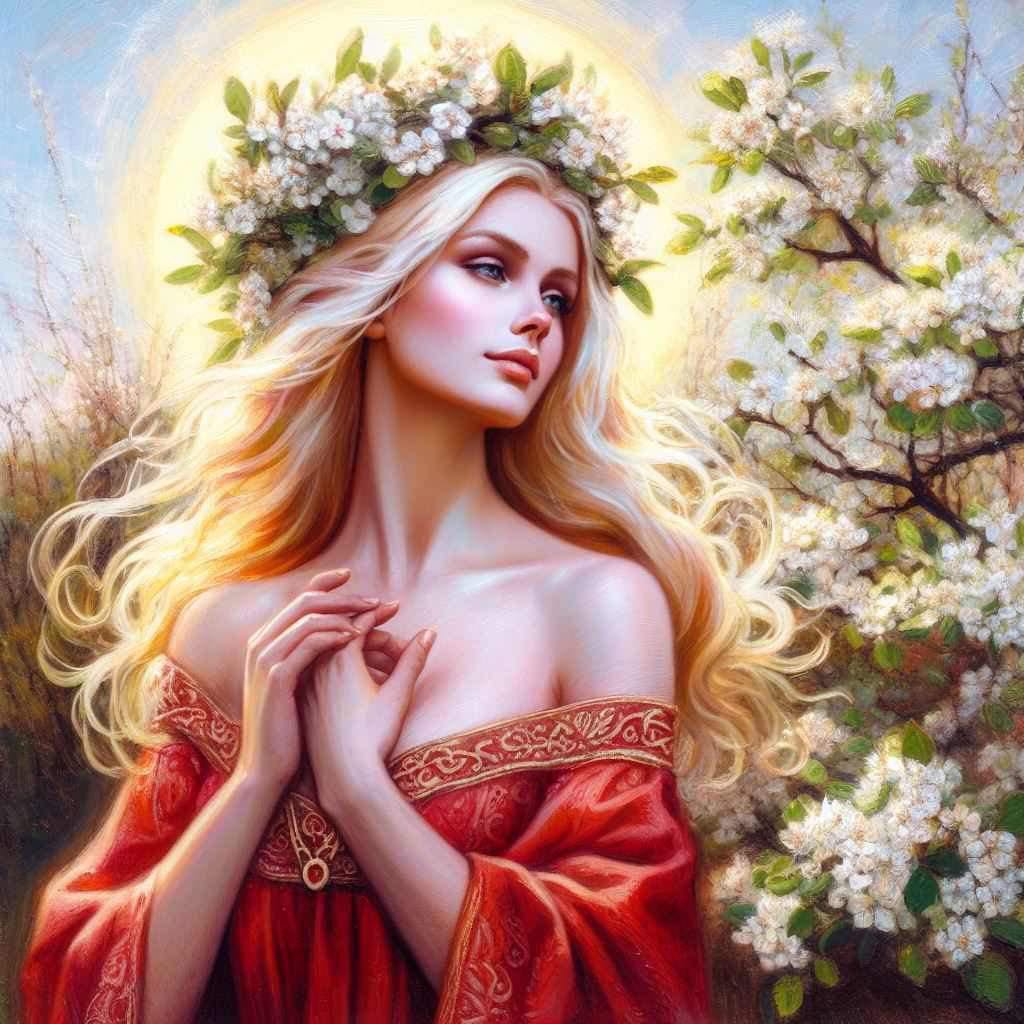
Further study:
- Blodeuwedd: Welsh Goddess of Seasonal Sovereignty by Jhenah Telyndru
- Rhiannon: Divine Queen of the Celtic Britons by Jhenah Telyndru
- Ladies of the Lake by Caitlín and John Matthews
- Courtly Love: The Path of Sexual Initiation by Jean Markale
- Priestess of Avalon, Priestess of the Goddess by Kathy Jones
-
The Maiden of Spring: Hope and Sorrow

Well, it’s been a hot minute!
I know I’ve abandoned this blog, and I can’t say for sure that I’m ‘back’, but I am going to try to post on here at least once a month going forward.
For the last 3 weeks or so I’ve not been in a great mood, ranging from just kind of low to completely emotionally distraught to feeling just numb inside. I deactivated Facebook, stopped replying to inboxes and have spent a lot of time just enjoying my own company and resting, experiencing an inner winter even as spring is blooming.
Today is the spring equinox, with the fixed modern pagan observance of Ostara happening tomorrow on the 21st. Walking to and from work this week has been lovely. Monday in particular had beautiful weather and I decided to walk to work instead of getting the bus, but regretted wearing a jumper, leggings, long boots and my winter coat when I could’ve at the very least gotten away with my denim jacket instead of the coat. It’s that awkward time of year where you never know how to dress.I always really notice a palpable energy shift this time of year. I don’t just mean because the weather is different and because the earth looks different, but it feels almost like in late March we’ve stepped into a slightly different version of the world. It’s not something that can be described logically with words, but something you just feel with your body & soul. In the Celtic traditions, liminal spaces are seen as extremely magically potent. The shift from winter into spring and the shift from summer into autumn are, to me, the most magically potent times of year because they are extremely liminal. The shifts from autumn to winter and spring to summer are noticeable too, but not almost as much.
Many of the trees are covered in lovely, delicate pink blossoms. The Earth Goddess wears the mantle of the Spring Maiden. Women’s mystery traditions such as Dianic Witchcraft and the Glastonbury Avalon tradition observe the seasons as the Goddess ageing, dying and being reborn, and the uncanny resembles that has to the cycles in human women’s own lives, be that on a macro level (birth to death), or a micro level (our menstrual cycles). Other Neopagans view the Goddess as ageless and it is instead it is Her son or lover who goes through this process. Some see it as both. In the Filianic tradition which I used to be a part of and still somewhat align with, as Neoplatonists it is believed that the cycles of the earth reflect eternal truths and metaphysical events that take place outside of matter, time and space. Filianism celebrates the death and rebirth of God the Daughter, the World Soul who mediates the light of the Divine Mother to us here on earth.
Goddesses who embody the archetype of the young spring maiden (who I typically see as a teenager of about sixteen years old) include Ostara/Eostre (who, regardless of whether or not she was an invention by the monk Bede or actually worshipped, certainly is a goddess who is worshipped and adored today so it doesn’t matter. I also personally do believe she was really worshipped, and an obvious descendant of the H₂éwsōs lineage of Indo-European dawn goddesses), and Kore/Persephone. You could broaden this to include Brigid, though I’m specifically talking about goddesses often associated with this time of year and Brigid is obviously more associated with Imbolc. Similarly, you could broaden this category to include the May Queen goddesses such as Flora, Olwen, Gwenhwyfar, Creiddylad and Blodeuedd, though in terms of women’s mysteries archetypes I see them as embodying the Lover archetype which I see as a woman in her twenties, and they are obviously more associated with Beltane.
The element and cardinal direction associated with the season of Spring will differ depending on your tradition. In the Glastonbury Avalon tradition, it is associated with the cardinal direction East and the element of Fire. In Filianism, it is also associated with the cardinal direction East but instead of Fire, the element of Water. I can see arguments for both of these. On the one hand, the sun rises in the East and Spring is associated with the rising of the sun, which is a huge ball of fire. Fertilising heat quickens and awakens the land from slumber. On the other hand, it also makes sense for Summer to be associated with Fire instead, leaving Water for Spring. In many parts of Europe, especially here in the UK, Spring (especially March and early April) still tends to be very wet (although this is changing due to global warming).
But related to the idea that spring is the season of water, I wanted to explore a quote I read about the Spring Maiden recently, and relate it back to my life and personal journey at the moment.
“Ostara is usually experienced as a young maiden – as Ember Cooke writes, ”…old enough to bear children, but not a mother.“ She is wreathed in flowers or new greenery, and often dances.
She is often joyous, but can just as easily turn suddenly solemn, like the spring weather that can quickly turn to rain.
Like Spring itself, she is capricious, innocent and knowing by turns.
Hail to the Maiden of Spring, the dawning of the year! Bring freshness into all our lives.”
I have been feeling so upset with myself for not feeling all positive and perky now that spring is here. But just as I was able to partially heal my fear of getting older by observing that many of the most fecund, passionate, lusty beautiful gifts of the Goddess of Love and Beauty don’t occur until mid summer (roses) to late summer and early autumn (apples), once again Nature teaches me that to embody the Spring Maiden isn’t always to be a smiling, dancing, positive sweetheart. Patriarchal modes of being and thinking love femininity when it’s all pretty pink blossoms and giggles and a soft touch, yet they shame our emotional expression, complexities and depth. This is why it’s incredibly important to recognise when men say they want feminine women if they want feminine women in their fullness, or feminine women who are only feminine when it benefits them. The Spring Maiden archetype is one of two feminine archetype that patriarchy has accepted the most, as well as the abundant Summer Mother, but even these archetypes have aspects that patriarchal men who don’t actually like femininity (even if they insist they do) are threatened by.
Water is the element of emotion, and so if we believe spring to be the season of Water, that means accepting the Spring Maiden for all these She is, not just the easy-to-appreciate pleasant parts, and for all that we are, too. And so, it’s okay that I’m struggling right now. My rainclouds are just as beautiful as my blossoms.The Spring Maiden is identical to the Dawn Maiden. Dawn and Spring symbolise hope, renewal, and indomitable innocence and optimism that refuse to be crushed by the cruelty of the world. Sadness only becomes all-consuming once you abandon the spirit within you that
believesKNOWS things can get better. I might be lonely and hurting over my dating prospects right now in a world that seems to be abandoning virtue, monogamy, marriage and family, but I refuse to believe that all men are like that and that chivalry and romance is completely dead, no matter how man voices tell me it is. On a much more important note I look at what’s going on in Palestine at the moment and while it’s incredibly tempting to just lose yourself to despair, I see beautiful smiling, laughing children in refugee camps, and I remember that if they can keep their innocence and hope alive, I have to, too. For them, for myself, and for the world. Evil only wins once we lose hope that it can be defeated. “We’ll cry tonight, but in the morning we are new // Stand in the sun, we’ll dry your eyes.” – Arise, Flyleaf.You can listen to my Ostara playlist here.
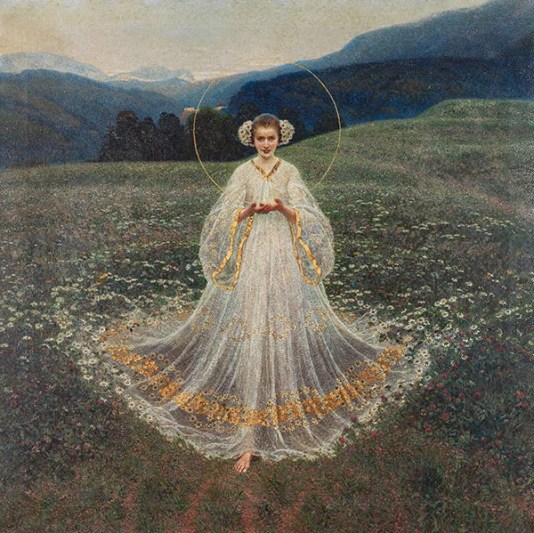
~ Rhianwen
-
Finding The Solar Goddess of Love: A Look at UPG and Recorded Lore

Daylight by Taylor Swift Hello beauties. I hope if you’re in the Northern hemisphere like me, you’re enjoying the last of our summer days.
Here in the UK it has rained most days for the past six weeks. We had summer solstice, and then immediately after the jet stream and low pressure has doused us with nonstop rain, a sharp contrast to the droughts and heatwaves of last summer. In a way, it’s a good thing. The land probably needed it. I remember this time last year spending a week down south, and everywhere we went the grass was brown and dead. This year everything is beautifully green. Green and soggy. I really miss the sun. I’ve spent so much time inside. Last summer I spent hours every day sitting in my back garden soaking up the rays and feeling the warmth of the Divine Lady Sun Goddess kiss every inch of my body.
Which is my segue in to the topic of this blog post. The solar feminine, and specifically, the ‘solar goddess of love’.
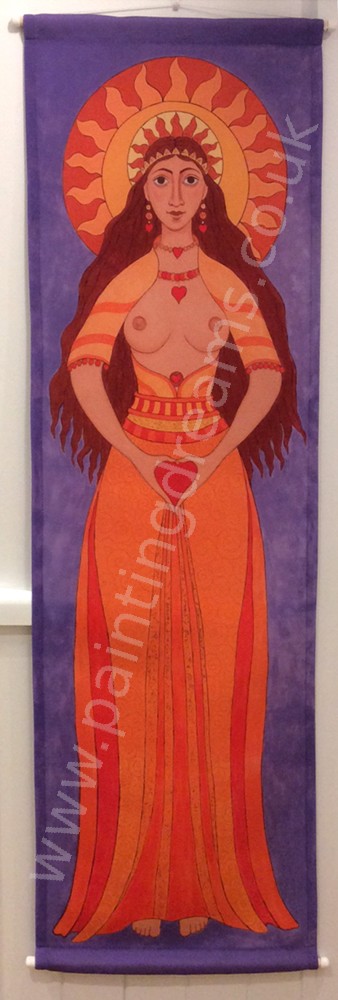
Art by Wendy Andrew Last night at my moot, we listened to an illuminating talk about the origins of sun worship and the role it plays in our lives today as modern pagans. Most modern pagans focus more on the moon, which makes sense. In a world where solar energies have been the focus of patriarchal religion for thousands of years, and on a planet which is being devastated by global warming, it would make sense that many of us would want to seek refuge in cooler, gentler lunar energies- which are typically viewed as divine feminine energies. The sun, in many cultures, has been seen as masculine. This does make sense. If the earth is feminine, the womb of creation, the sun is the fertilising aspect of creation that joins in union with Mother Earth so that she can birth life. The rays can be seen as phallic, and the firey, sometimes angry nature of the sun can be compared to warrior-like energies. The moon and the earth, meanwhile, are typically seen as feminine, with the moon representing the mystical, intuitive aspects of the feminine (like the High Priestess card in the Tarot) and the earth representing the fertile, fecund aspects of the feminine (like the Empress card). This makes sense, and it works for plenty of people. For me, however, I’ve always felt more connected to not only solar energies, but specifically, divine feminine solar energies. I’ve tried, for years, to convince myself I should just do what everyone else does and go along with the solar masculine/lunar feminine dichotomy. I spend a lot of time in what many would class as ‘new age’ spaces, and that’s the party line at those. And I have no problem with them doing that, but it’s not me. It is so reductive and dogmatic to state with absolute conviction that the sun is masculine, when world history has gave us probably just as many sun goddesses as sun gods.

There are many reasons the sun has became much more associated with the masculine than the feminine in modern paganism and occult/magical thought. The incredible book Drawing Down the Sun gives some reasons for this, one of the major ones being the popularity of Max Müller’s theories at the time. Müller hypothesised that every single myth told the story of a heroic male solar god overcoming the darkness. His theories were later debunked, but certainly stuck around long enough to play an active role in what would later become the pagan revival movement. I’ll share a quote of hers below, but I really recommend buying the book and reading the whole thing. The chapter at the beginning, the Hidden Sun, goes in to a lot of detail about why the erasure of the solar feminine has occurred.
Ultimately, an active female sun would not have agreed with the morals and social taboos of the Victorians. Their interest in a universal language and making ancient myths fit the mold of Christianity made it impossible for the solar feminine to be recognized. A woman playing such a vital role in religion didn’t fit into their worldview. The passive, gentle moon reflected the ideal woman of the time far better than the vibrant, sometimes warlike sun. The popularity of classical myths further ingrained as the norm the idea of male/sun, female/moon.
Drawing Down the Sun by Stephanie WoodfieldThe solar feminine, to me, is also the Empress card in the Tarot just as much as the Earth is. She is Hemera. Helen of Troy. Eos. Aurora. Theia. Demeter. Dea Dia. The Sun Goddess of Arinna. Aditi. Hathor. Sekhmet. Bast. Isis. Aine. Rhiannon. Olwen. Gwenhwyfar. Elaine of Corbenic. Elen Luydogg. Iseult. Brigid. Grainne. Amaterasu. Sunna. Sulis. Eostre. Ausrine. Ostara. Hewsos. Saule. St. Lucia. Sai Rayya. Sophia. So many more.
While I do not want to bring gender stereotypes in to this so much (seeing as even the very fact that I view the sun as feminine contradicts typical modern Western gender associations), there’s a point I want to bring up here. Many people view the sun as masculine because its heat can be fierce, angry, full of rage, like a masculine warrior. In hot countries, the sun was often viewed that way (sometimes with sacrifices made to appease him). But in colder climates, especially in the North, the sun is more like a gentle lover, leaving kisses all over the land and radiating us with her presence. Some scholars have identified that Northern countries often opted towards sun goddesses, because its loving and gentle warmth would’ve been seen as feminine, whereas in hot countries closer to the equator the sun would be seen more as masculine because of its angry and often violent nature. Egypt is an interesting case because they had both male and female solar deities, and two solar goddesses who were two sides of the same coin, Hathor and Sekhmet, that embody both aspects of the sun.
Since I live in the rainy UK and suffer from Seasonal Affective Disorder in the winter, the sun to me is like a gentle lover who awakens me from my slumber. She blesses the land, and me, with Her solar kisses. In the spring time, she signals the animals, the land, and us to awaken. Animals begin reproducing at Her call. When I lie on the grass in the summer (fully covered in sunscreen- gotta be safe) and lay back, the feeling of Her rays on my skin feels like being wrapped in pure, divine, ecstatic love. I have a high heat tolerance, and when most people are suffering through heat waves, I am living my best life sitting in the shade and reading a book in a cute sun dress. Her playful games of hide and seek as she retreats behind clouds and slowly re-emerges make for breathtaking works of art in the sky, which fill me with awe and remind me of the love the Creator has for all of us. When She rises in the morning, She paints the sky all sorts of different hues: yellow, orange, pink, blue, purple, as the birds sing for Her. When it rains, She paints the sky with even more colours with beautiful rainbows. When She sets at night, She makes everything golden, and this is my ideal time to take selfies because I have warm undertones and cool lighting does nothing for me! Even in the winter, She is a paler and cooler shade of yellow, but in some senses even brighter, and clear winter days can be just as exceptionally beautiful as summer ones. One of my favourite words is ‘Apricity’, which refers to the warmth of the sun in winter. I think of the Sami people, who have worshiped the sun for thousands of years in their icy climate, and the love they have for Her as she brings love and light to their frozen landscapes.
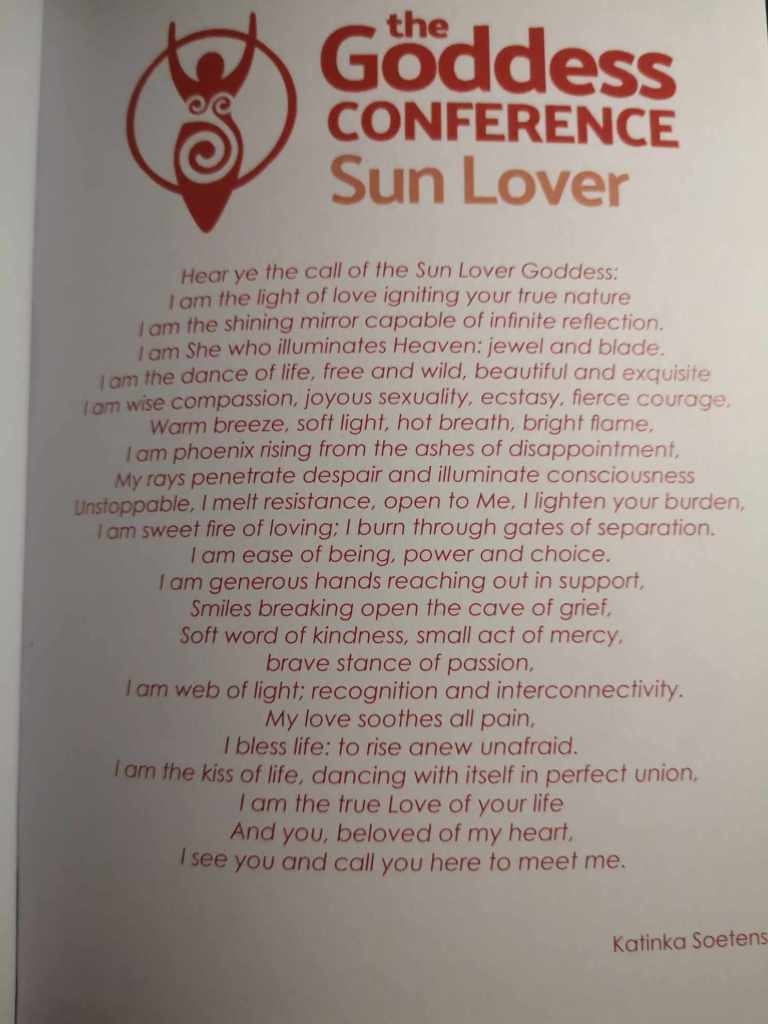
For these reasons, the sun, to me, is a symbol of love in all its forms: the love of a mother for her children, the altruistic love we ought to have for all of mankind, the love of a romantic couple in the throws of passion on their wedding night. I feel deeply connected to what I call the ‘Solar Goddess of Love’, which, interestingly enough and annoyingly enough because I wasn’t there, was the theme for the Goddess conference in 2019. The problem is, I don’t know what name I should call Her by. An obvious choice for a solar love goddess would be Hathor, but I know so little about Kemetism and have no connection to the land of Egypt, and want to stick in my relatively nearby and/or ancestral spheres. There is also Eos/Aurora, who takes many lovers, who is very near and near to my heart and I am incredibly fond of the Indo-European dawn goddess in all her forms, but again, I want to stick to the Celtic spheres. I have some hunches, and I have nailed it down to a few choices. I’m focusing on Celtic goddesses who I can link both to love and the sun, not one or the other.
Olwen
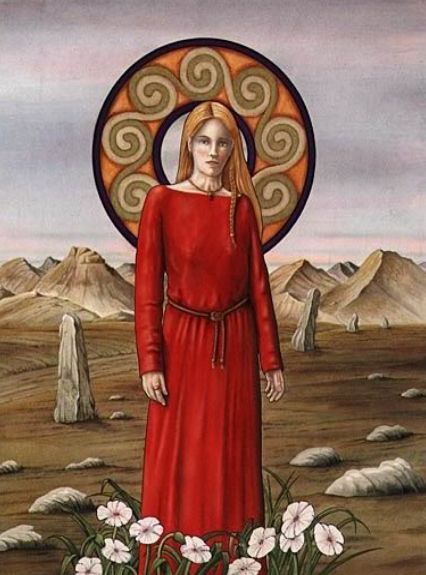
Olwen was the focus of an article I wrote in May here. I’ll touch on something here that I didn’t very much there, though. One aspect of the sun goddess, and the sun in general, is that of the descent in to the underworld and ascent back out of it. This is typically associated with Venus because of Her journeys through the sky, but the sun literally makes this same journey every night. In to my research in to Olwen as a sun goddess, I found several articles arguing that Olwen’s story can be interpreted similarly to that of Creiddylad’s, Guinevere’s and Blodeuwedd’s love triangles, aka the goddess being with the king of summer/solar hero half of the year and the king of winter/otherwordly champion the other half of the year (consensually or non-consensually, depending on the story and the lens through which the story is interpreted- but that’s a topic for another day). The difference is, the ‘winter king’ in Olwen’s story isn’t a lover, but her own father who will die if she marries. Her father, Ysbaddaden Bencawr, is an ancient giant, representing the old order (winter) trying to cling to his throne. The young Culhwch, then, is the untested solar hero seeking the hand of the Goddess. This story in the Mabinogion also features the love triangle between Creiddylad, Gwythyr, and Gwyn ap Nudd. Gwyn is the King of the Otherworld/Underworld (the two are often conflated and seen as one in the same). The ‘otherworldly champion’, ‘winter king’ figure represents cthonic values of darkness, chaos, magic, death and descent in to the underworld. When the solar goddess, or the nature goddess, is with him (be it as her father or her lover), she is in the underworld. When she is with the solar champion, who represents order, law, life, and logic, she is on the land or in the sky. The night and winter are obviously thematically connected, as are the day and summer. In this regard, Olwen and other sun goddesses can be seen as psychopomps, bringing their light to the dead and the souls in the Otherworld/Underworld when they descend down there at the dark half of the year, and bring them life anew as reincarnated souls at the start of the bright half of the year, like the Divine Daughter in Filianism. As I said in my original Olwen post, in my UPG Olwen is a ‘Lover archetype’ goddess and I associate her with sacred sexuality, viewing her similarly to how Rhiannon is often viewed in the Avalonian traditions of Glastonbury.
Rhiannon

Art by Wendy Andrew Rhiannon, in modern pagan circles, is for some reason often viewed as a lunar goddess. To be honest, I’m yet to find the reason for this. A big part of me wonders if its to do with the fact that the witchy figure in the song Rhiannon by Fleetwood Mac has become conflated with Rhiannon of the Mabinogion to the point people can’t tell where one ends and the other begins. More likely, though, it has something to do with the Wiccanised ‘every goddess is a moon goddess’ idea that is still firmly embedded in the Neopagan collective consciousness. Rhiannon, to me, is solar. She wears a gold dress, an undoubtedly solar colour, and is obviously a horse goddess. Horses, in most Indo-European traditions, represent the sun and the solar chariot. She, too, can be interpreted as a psychopomp figure in some senses, with her birds, the Adar Rhiannon, that can ‘wake the dead and lull the living to sleep’. At this year’s Goddess conference Katinka Soetens did an amazing talk on birds as psychopomp figures. Her journey across the land in her gold clothing (solar symbol) on her white horse (solar symbol) mirrors the journey the sun takes across the sky each day. While not much in Rhiannon’s story points to her being an obvious ‘love goddess’ upon first reading, her union with a human man to bless him with the sovereignty of the land can be read similarly to ‘Hieros Gamos’, the love-making between a priestess of the Goddess Inanna and a King in the Middle East to bring prosperity and abundance to the land. In this sense, many Celtic sovereignty goddesses can be read as love goddesses, but Rhiannon’s story speaks of not only love for a mortal man that she chose, but love for humankind, when she chooses to accept her punishment even though she knew she didn’t kill her baby rather than call her traitorous handmaidens out for lying. Today, many of her devotees have had direct experiences with her in which she manifests to them as a goddess of love, beauty and sacred sexuality, and that makes infinitely more sense to me than viewing her as a goddess of witchcraft and the moon, which some modern sources claim her to be. Many modern artistic depictions of her, such as the one above, depict her in red rather than gold. Possibly for two reasons: showing her as a goddess of love and sexuality, and also because the colour red is associated with the Otherworld from which she hails. Many of these depictions remind me of Olwen or Aine. I love the picture above, because of the large sun behind her. I assume the aquatic imagery is because of her later marriage to Manawydan, often interpreted as a sea god cognate with the Irish sea god Manannán mac Lir. I’ve seen other more modern ‘love goddess’ depictions of her with the sea, too, so I’m wondering if it’s also some syncretism with Aphrodite/Venus going on.
Áine

(Content warning for rape). Alright, hands up, I know fairly little about Irish paganism (other than Brigid) and I have not sat down and properly read Áine’s story. After writing this article, I’m going to make a concerted effort to do as much research on her as I can. From what I understand, she is a ‘fairy queen’ (which we all know is basically code for goddess) who is raped by various men seeking to be king, as she is a sovereignty goddess, like Rhiannon, and one must join in sexual union with her to be able to rule. However, it must be a union she consents to, as it is HER choice who the king is, and HER choice who she will sleep with. She righteously punishes these vile men and remains a powerful, sovereign goddess of love and beauty, and takes several lovers. Some believe her to be the lover of Manannán mac Lir, though some have him down as her father. Her name means ‘brightness, radiance, glow’ which obviously points her to being a sun goddess, though some interpret her as a moon goddess also. She is celebrated at Midsummer, obviously pointing to her solar associations. I placed her oracle card on my Midsummer/Litha altar this year. Considering her links to Manannán, her sovereignty goddess status, and the fact that she is also associated with horses, it’s reasonable to wonder if she derives from the same proto-goddess as Rhiannon, though I can’t prove that and would have to read more in to it. Some believe Áine’s sister to be another Irish goddess Grian/Gráinne, who weds the god of the underworld. Gráinne may also be another aspect of Áine herself. The two potentially represent the sun goddess in the light half of the year, and the sun goddess in the dark half of the year. Certainly Gráinne aligning herself with the god of the underworld points to the love triangle of seasonal sovereignty we see played out in Celtic myth again and again. I really like this idea of two sister sun goddesses for both halves of the year because, since I’ve been a kid, I’ve always felt like the winter sun and summer sun had very different energies, almost like they were two different luminaries. There’s a great article on this here.
There are a few honourable mentions, whom I also considered, but didn’t have enough to say on to justify their own paragraphs.
- Iseult: Not a goddess so much as a literary figure (but then the same can be said of a lot of the goddesses I worship, and it’s possible she, like many of them, is a humanised form of an earlier goddess). No direct links to the sun but her role as a skilled healer (the sun can be associated with healing) and a quote I read a while ago (see below) make me consider her a solar heroine. She is also, obviously, a figure associated with love and beauty and has been compared to Helen of Troy, another solar love figure.
- Elen Luydogg: While this story in the Mabinogion basically just serves as justification for the Roman colonisation of Britain, Elen’s depiction as a regal, golden-garbed (see a pattern here?) queen calling to the man she loves through his dreams to come and take his place by her side is very beautiful if you strip back the whole colonisation thing. The figure of Elen is a whole thing. There are a few different Elen’s all associated with Wales and sovereignty and to be perfectly honest with you I still don’t know where one ends and another begins. Don’t even get me started on the Elen of the Ways debate. Caitlin Matthews in the incredible book King Arthur & the Goddess of the Land speculates that she is related to Elaine of Corbenic, and though this is highly speculative conjecture, it’s worth mentioning. Wonderful priestess Ann of the Sheffield Goddess Temple wrote an article on similar lines about this elusive Elaine/Elen figure here as she was a goddess chosen for the circle of nine at the 2022 Goddess Conference which was themed on the Celtic sovereignty goddess.
- Brigid: Whilst Brigid is an obvious choice for Celtic sun goddess, she is not super related to romantic love, which was why I’m not sure if she’s the sun-lover goddess I’m looking for. That being said, she’s still a sister of her. Brigid has so much abundant, overflowing love for all of humankind, and does have different consorts depending on the story. Despite this, though, the sun-lover goddess I feel in my heart and soul has an obvious link to romantic love as well as altruistic love, and I’m just not getting that from Brigid. She is still a goddess very near and dear to my heart, though.
- Gwenhwyfar/Guinevere: Much of what has been said about virtually every goddess I’ve discussed in this article can also be said about Gwenhwyfar. She is an obvious figure of romantic love. She is the Queen of the Light Half of the Year (which Morgana being the Queen of the Dark Half of the Year) in Arthurian-influenced modern paganism. She is the sovereignty goddess who is often in a love triangle with Arthur, the solar hero, and various other men who represent the otherworldly champion archetype. Much of how I work with her, not just as an Arthurian queen but also a Brythonic goddess, is UPG based. Yes, she is the spring maiden like Blodeuwedd, and the summer queen like Aine, but she also has autumnal and winter aspects where she appears to me as a white goddess of death similar to the Cailleach or Ceridwen. Part of me believes this to be her sister aspect, Gwenhwyfach. I see her as both solar and lunar, depending on which side of the year she is representing. Interestingly enough, I know for a FACT I read something a while back that said someone had theorised Guinevere as a dawn goddess. It was either Max Müller or someone who believed in his theories and was working within his solar myth framework. However, I now can’t find it for the life of me and feel like I’m being gaslit by the internet. She has, however, always had solar energy to me (as well as lunar, like I said) and I’ve heard at least one other person share this UPG on a podcast, citing a vision she had of her as the ‘goddess of the golden wheel’ to Arianrhod’s silver wheel (which I’ve also seen said about Olwen). At one point soon I think I’ll write a full article on my views of Guinevere/Gwenhwyfar as both solar May Queen but also ‘white shadow’ goddess of death and winter (potentially her Gwenhwyfach aspect) which is very UPG based.
Here is a quote I read a while ago about the solar feminine, specifically pointing to the solar feminine’s function as Goddess of Love. This is the quote I was talking about above when I discussed Iseult/Isolde.
And again in the Irish heroine, Grainne, whose name comes from the Gaelic grian, “sun,” and who is the prototype for Isolde the Blonde. Moreover, isn’t it worth noting that, in modern Germanic and Celtic languages, the sun retains the feminine gender while the moon is masculine? It is even said that Tristan, the moon-man, cannot live for more than a month without having physical contact with Isolde, the sun-woman.
The Great Goddess by Jean MarkaleWe are about to enter in to the dark half of the year (or we already have, depending how you split the year). For most of my friends, this is a celebratory occasion, as many can’t stand summer and can’t wait for cosy cardigans, pumpkin spice lattes, and Samhain celebrations. But for me, I know my already precarious mental health is about to dip once again. But I have to remember that even when the goddess is in the underworld, she won’t be there forever, and neither will I. I have recently completed orientation in to the Sisterhood of Avalon, and am about to start the Avalonian Cycle of Healing shadow work practices as outlined in our founder Jhenah Telyndru’s book, Avalon Within, beginning with the Station of Descent. I am a solar, love-and-light energy type of girl, and always will be. But that doesn’t negate the parts of me that are darker, lunar, and wintery, that I must shine my solar light on to, and learn to love.
I am leaning towards Olwen as the ‘sun goddess of love’ that I am called to honour, but I know that whatever her name is, she is always with me, loving me, inspiring me, healing me, bolstering me, and filling me with energy. May I be Her Moon, Her priestess that reflects Her light to the world.
I hope you always feel the love of the solar goddess of love. I respect that, with the temperatures of our planet rising because of human error, the sun isn’t exactly a gentle, sweet lover in everyone’s eyes anymore, even here, far away from the equator. But let us reminder the Goddess is a Destroyer as well as a Creator, like Sekhmet, solar warrioress aspect of Hathor. May we begin to treat our planet with the respect she deserves, so the sun can remain a kind and sensual lover as much as possible.
I leave you with the lyrics to the beautiful song Hunter Moon by Kate Rusby, in which the moon is in love with the sun, who is female. Go listen to it, though, instead of just reading the lyrics. I promise, it’s worth it. Go listen to Daylight by Taylor Swift, as well, while you’re at it.
Softly the morning light,
Softly the dew,
Softly my soul will bend,
As she comes in view,
At dawn she is delicate,
And burning by noon,
The end of the day will come soon.And the stars in my lonely sky,
Are infinite bright,
And the stars know my soul will fly,
They’re holding it tight.There she is rising now,
My heart it might break,
The birds in her warmth will fly,
My soul it will ache,
And the world comes alive for her,
In awe at her gaze,
And suddenly the sky is ablaze,And the stars in my lonely sky,
Are infinite bright,
And the stars know my soul will fly,
They’re holding it tight.Say not her name to me,
For I live in the shade,
Briefly I see her,
As she starts to fade,
In silence we pass,
Our path is well worn,
In silence I wait for the dawn.And the stars in my lonely sky,
Are infinite bright,
And the stars know my soul will fly,
They’re holding it tight.Calmly I drift along,
Oh I will endure,
I only belong to her,
Of that I am sure,
Will I ever hold her,
I cannot presume,
For she’s the sun,
I’m only the moon.And the stars in my lonely sky,
Are infinite bright,
And the stars know my soul will fly,
They’re holding it tight.And the stars in my lonely sky,
Are infinite bright,
And the stars know my soul will fly,
They’re holding it tight.~ Rhianwen
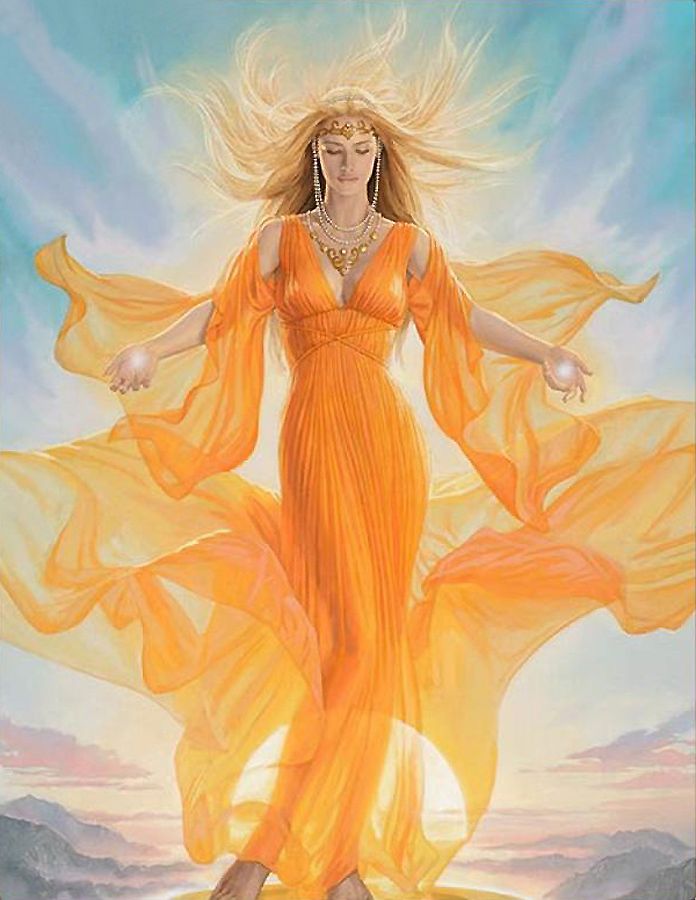
Some book recommendations on the solar feminine:
- Sun Lover Goddess Myths (x)
- Drawing Down the Sun by Stephanie Woodfield
- O Mother Sun! by Patricia Monaghan
- The Sun Goddess by Sheena McGrath
aine, brigid, celtic paganism, celtic polytheism, divine feminine, elaine, elen, goddess, goddess of love, goddess spirituality, grainne, guinevere, gwenhwyfar, irish paganism, irish polytheism, iseult, isolde, love goddess, lover archetype, lover goddess, olwen, pagan, paganism, rhiannon, sacred sexuality, solar deity, solar feminine, summer, sun deity, sun goddess, welsh paganism, welsh polytheism -
Olwen: May Queen and Solar Goddess of Love
I know I said I was done with the Beltane/Calan Mai/May Day posts but we’re still in Beltane season until the solstice so I lied. And I have a couple more ideas for Beltane related posts. So there.
One of the Beltane/May Queen goddesses I’ve not really talked about is Olwen of the White Track. She is much more obscure and not as widely acknowledged in Brythonic polytheism/the Avalonian based traditions as her similar sister-goddesses Gwenhwyfar, Blodeuedd, Rhiannon etc. (Creiddylad, Yseult etc too but they’re also quite obscure).

artist unknown In the main text in which she appears, Culhwch and Olwen, she does not appear much in the story because obviously it’s a tale of Manly Knights doing Manly Knight Things, but she is the reason they headed off on their adventure to begin with, as in order to marry her, Culhwch has to go on an epic quest which will prove his worthiness to her father, Ysbaddaden (whose name refers to the hawthorne tree, an obvious link to Beltane), who will die if she marries. Many believe him to represent the old Winter King who does not want to give up his throne, with Olwen as the Flower Bride waiting to be set free from this overprotective paternal figure- one of the oldest examples of stories about fathers who believe no man to be good enough for their daughter, perhaps. This leaves Culhwch as the young, untested Summer Lord who needs the hand of the Flower Bride to begin his reign as Summer King.
But what makes Olwen so different from the other Flower Brides (other than it being her father and her potential lover who she is the hinge in the love triangle between and not two lovers) is, to me, she seems to have more agency. We do not hear things from her point of view, but she seems to actually be attracted to Culhwch. Culhwch asks for her hand, and she simply says her father won’t allow her to marry, not that she doesn’t want to. Red, to the Welsh Celts, was not, as far as we know, associated with sexuality as it is today, but represented the Otherworld (along with white). When we think of most of the Flower Brides, who many associate with the Maiden aspect of the Goddess, we think of them as wearing white. But Olwen, she wears red. From a contemporary comparative mythology and symbolism perspective, this to me indicates she is ready to become sexually active and enter in to the Lover stage of her life, the transitory period between Maiden and Mother. In the Avalonian tradition of Glastonbury Goddess Temple, Maiden, Mother, Crone is stretched to Maiden, Lover, Mother, Crone, with the Lover archetype representing Beltane (the Maiden instead represents Imbolc, the Mother at Lammas, and the Crone at Samhain). Olwen isn’t a passive figure who has little control over her fate like Creiddylad, or forced in to a marriage she didn’t consent to like Blodeuedd, or married for political reasons like Guinevere/Gwenhwyfar. She seems to actually want to marry, and it’s simply her father holding her back. Not to say that we cannot interpret the aforementioned goddesses as having agency too (the latter two definitely express agency in choosing who to love later on in their stories), but I feel like with Olwen there’s less reclamation that needs to be done. As well as her signature red gown, she is described as wearing many rings upon her fingers, and a necklace of red gold and jewels. She is fully aware of her beauty and sexuality, as opposed to a white-robed, demure, innocent maiden. It’s UPG and modern comparative mythology, sure, but I feel like Olwen is, probably along with Gwenhwyfar, the Flower Bride who is the most aware of her role as passionate Lover. Her red gown such as those worn in depictions of sensual Irish goddesses Áine and Medb, and jewellery worn by the likes of the Nordic love goddess Freya and Mesopotamian love goddess Inanna, tell her father “I’m not a little girl any more, dad.” I think about the way the Glastonbury Avalon tradition depicts Rhiannon, and that’s very close to how I view Olwen. I wonder if parts of Olwen’s energies are being channeled in these more modern depictions of Rhiannon as Lover Goddess.

Rhiannon altar at Glastonbury Goddess Temple or House Her name is said to mean ‘white track’. Where she steps, tiny flowers bloom below her feet. Like Brigid, and Ostara/Eostre, she arises from the underworld out of slumber to awaken the land. Today, while I was walking through a local green space to feed the birds, there were thousands of daisies. One of the best things about this time of year is the little wildflowers that cover the grass. There were so many daisies that I could smell them in the air as I walked. I imagined myself as Olwen, awakening the land with my footsteps.

There is some etymological research to suggest her name means ‘Golden Wheel’, in contrast to the Silver Wheel of Arianrhod, which may make her a sun goddess, due to the fact that the word ‘olwyn’ is believed to have meant Wheel, though I’m unsure where the ‘golden’ part come from. As a spring/summer goddess, she certainly is aligned with solar energies. Arianrhod doesn’t have as clear of a connection to the moon as people may think (though she certainly does with the stars), but as I’ve said in the past, modern interpretations of the domains of these deities aren’t invalid just because we can’t find indisputable proof for them. The silver wheel in Arianrhod’s name, if indeed ‘Rhod’ does mean wheel, I suppose could be due to her association with the Corona Borealis. That being said, I see no reason why modern pagans shouldn’t be able to associate Arianrhod with the moon. Moving back to Olwen, I get annoyed by the New Age and Wiccan idea that all goddesses are lunar and all gods are solar, when the Celtic pantheons and other European pantheons have no shortage of solar goddesses and in the Nordic tradition, the sun is female and the moon is male. One theory as to why there are more sun goddesses and moon gods the more north you get is that in warmer climates, the daytime sun is viewed as a harsh and aggressive force, associated with masculine energy, whereas the night is cool and gentle, associated with feminine energy. Whereas in more Northern climates, the nights are bitter and hard, whereas the warmth of the sun is benevolent and loving. I’ve always been drawn to solar goddesses, and Olwen is no exception.
In another story, Einion and Olwen, a young shepherd travels to the Otherworld, wins her heart, and the two marry and have Taliesin. Olwen exercises plenty of agency in this tale, falling in love with Einion and wanting to marry him rather than him just pursuing her which is often the case in these stories. She has two sisters, pointing to a triple goddess, like Gwenhwyfar in the Welsh Triads, the three Brigids etc.

By Judith Shaw from her Celtic Goddess Oracle Card deck I have read her described as being the keeper of the Apple Orchard of the Otherworld, a role that is often given to the god Afallach, his daughter Modron, Morgan le Fay, and various sovereignty goddesses associated with the Otherworld. Given Olwen fits nicely in to this archetypal ‘family’ of Otherworld deities, and her associations with the colour red and love, I can accept this correspondence on the grounds of syncretism and comparative mythology, although I would like to find the source for it and the direct justification. Honestly, a lot of these sovereignty, love, spring and Otherworld goddesses are so similar that it can be hard to discern where one ends and one begins.
We can interpret Olwen as triple-aspected: when she is with her father during winter, she is the Lady of the Underworld. She then leaves with her lover to the upper world to bring about Spring, making her almost like a reverse Persephone. She is also a solar goddess, giving her heavenly connections. As such, she can be seen as Lady of the Underworld, Lady of the Earth, and Lady of the Heavens, just like Ostara/Eostre.
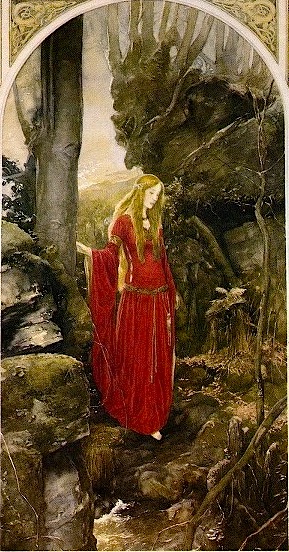
Olwen by Alan Lee The theme for the 2019 Glastonbury Goddess Conference was ‘Sun Lover’, a combination of the solar goddess & lover goddess archetypes. I cannot think of a better candidate for this than Olwen other than maybe Áine, who is an Irish goddess and therefore not as much of an ideal fit for an Avalonian tradition, but still relevant. I believe Áine was honoured as I read the little Sun Lover book published after the conference, but did not recall any mention of Olwen, which is a shame. I would love to see this powerful, beautiful, sensual, loving Goddess honoured more among those of us who gravitate towards Welsh traditions and the more neopagan, sacred feminine focused Avalonian traditions, especially at Beltane/Calan Mai, which is her time of year.
If you wanted to build an altar for Olwen, at Beltane or any time of year, here are some things you could include:
- Small white wildflowers, especially trefoils
- Apples
- Gold rings and necklaces
- Solar imagery and crystals associated with the sun
- Red altar cloth, red candles
- Rubies
- Broom flowers
- Red roses
- Hawthorne flowers
- A printed off painting of her, or a drawing you’ve done yourself
- Makeup
I believe Olwen encourages women to embrace their beauty and sexuality, inflames the passion between lovers, and encourages to be active participants in our own love lives. However, the fact that Culhwch had to perform thirteen impossible tasks to be able to marry her shows that we should have high standards for who we choose as our lovers, and we can invoke our inner masculine, our inner father, to hold that boundary for us if we feel we cannot do it with our feminine. She also tells us that ‘vanity’ is not a sin and its okay to want to dress up, wear makeup and jewellery and feel sexy and confident. When I put on my red dresses with matching signature red lipstick and gold jewellery, I instantly feel a boost of confidence and sexual, feminine power: Olwen’s influence. She also does not need to wait for a lover to awaken her sexuality, she seems capable of doing it herself, though she awaits her king to have someone to share it with. Therefore, she reminds me that I am capable of embodying the Lover Goddess and embracing my sensuality and sexuality whilst single, awaiting my king or queen to share it with.
Hail to the triple-aspected Lady of the Underworld, Lady of the Earth, and Lady of Heaven. Hail to the May Queen and Her King. Hail to the Summer!
~ Rhianwen
-
Beltane: The Coronation of the Queen & King of the Land

Beltane, or, as I’ve been calling it more often since I’ve adapted a more firmly Welsh/Brythonic influenced path (I have just applied to join the Sisterhood of Avalon), Calan Mai, is my favourite festival in the Wheel of the Year. Everything about this festival sings to my soul. I’ve always loved May. The transition from the beginning of April to the end of April is so stark. The days are much longer, the trees are approaching their leafy fullness, and every patch of grass is alive with daisies, dandelions, bluebells, forget-me-nots and more (in my neck of the woods, your local wildflowers may be different). In the UK, we have two bank holiday Mondays this month, too, with an extra one this year due to the king’s coronation (which, regardless of your thoughts on the monarchy, the day off is very nice, and metaphysically May is the best month they could’ve picked for a coronation).
Beltane is celebrated slightly differently across different pagan paths, but there are some shared themes: fertility, the sun, summertime, light, fire. Historically, cattle would be driven between two bonfires to purify them. People would wash their faces with the morning dew to bring them beauty and a youthful appearance throughout the year. Hawthorne branches would be gathered and homes decorated with wildflowers. When the Romans conquered Britain, the festival was syncretised with Floralia, the feast day of Flora, the Roman goddess of flowers, and young women would weave flower crowns in her honour.
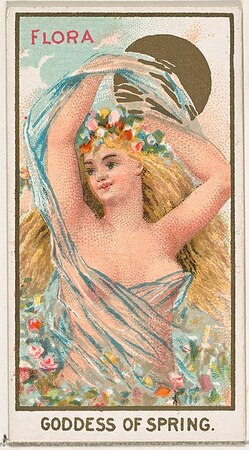
In my practice and Wheel observance, which is inspired by the various Avalonian traditions and Brythonic/Welsh mythology, Beltane is where we honor the Sovereignty Goddess in Her Maiden guise of the Flower Bride, known by many names such as Gwenhwyfar/Guinevere, Olwen, Blodeuwedd, Creiddylad, Bláthnat, Iseult & more. I’ve began to explain the Flower Bride deific to those unfamiliar with these stories by dubbing her a ‘Welsh Persephone figure’. Stories of the Flower Bride usually involve a love triangle, and she is always associated with spring time/summer time, and flowers, the Goddess that every May Queen embodies as well as the goddess Flora. Like all Sovereignty goddesses, a man cannot step in to Kingship or more broadly speaking any sort of true power or leadership unless he is married to Her. If we are to take Her consort as being a god as well as a mortal king in these stories, which is fair to do because we know many deities were demoted to mortals in the Christianisation of the Welsh tradition, it is fair to say that while She is always a Goddess, He becomes a God through Her, anointed and awakened through sacred sexuality. The phrase ‘men must become, women just are’ may have sexist connotations, but when applied metaphysically to divine masculinity and femininity, there is basis for it in some of our mythology. To me, this is because, if you imagine a wheel, the divine feminine is at the center at the divine masculine is the protective, moving rim, but there are many different perspectives on this. In some Flower Bride stories, she is kidnapped and passed from one man to another and seems to have little agency, leading some to perceive these stories as sexist. I completely understand that, but something to consider is that we don’t have to perceive it that way if we don’t want to! There is no metaphysical, spiritual or nature-based reason why we have to imagine the Flower Bride being forcefully passed between two men, OR as an unfaithful woman of loose morals committing adultery, when we can instead cut away all the baggage and get to the metaphysical HEART and thesis of the story, which is “Seasons and Kings come and pass, but the Goddess is forever.” Her two lovers usually fill these two archetypes: Otherworldly Champion, associated with Winter, (sometimes known as the Holly King), and Solar Hero, associated with summer (sometimes known as the Oak King). Who she begins the story with and who she ends up with depends on the story. In Blodeuwedd’s story, she begins married to the Solar Hero, and falls in love with the Otherwordly Champion. In Olwen’s story, while not her lover, her father can be seen as analogous to the old Otherworldly King, and the young, untested Solar Hero has to win her hand. Gwenhwyfar/Guinevere, throughout Arthuriana, is constantly being kidnapped by various Otherworldly/dark figures who obviously represent the Winter King, or betraying Arthur for the young Lancelot who is, interestingly enough, both more of a young/youthful Summer figure, and also an Otherworldly Champion seeing as he is raised by the Lady of the Lake. In Creiddylad’s story, where she begins betrothed to the Solar Hero and is kidnapped by Gwyn Ap Nudd who is absolutely an Otherwordly Underworld king, the story is open ended because she returns to her father’s house and the two men must fight over her every May Day. Whichever man steals away (either by consensually wooing her or by kidnap) the Flower Bride can give us a clue about whether or not the story is about the dark half of the year giving way to the light half, or the light half giving way to the dark half. However, since myths are supposed to be read not as literal events taking place within the realm of time and space (unlike the Abrahamic stories which we’re supposed to take as factual events happening in linear time), but eternal, out-of-this-world events that play out on the World Stage (the Plemora in Platonism), all of the stories can be read as a metaphor for Seasonal Sovereignty and when the story ‘ends’, it begins again and she returns to her original lover, and the story repeats itself. Another thing to consider is that some scholars believe that when the Flower Bride is seemingly ‘kidnapped’ by these mystical/otherworldly figures such as Gwyn ap Nudd or one of Gwenhwyfar’s various kidnappers, what is actually happening is that he was her original lover first who was kidnapped initially by the Solar Hero and he is merely taking her home where she belongs. Considering Flower Brides are very clearly otherworldly in origin, this holds up. The most interest example of this, to me, is Edern ap Nudd, brother of Gwyn ap Nudd, who in one story is adverserial towards Gwenhwyfar, but in another story is her lover who seduces her away from Arthur. Perhaps the Otherworldly figure was truly the good guy in these stories and him being demonised as a ‘kidnapper’ is simply a case of ‘history is written by the victors’ since the Solar Hero is much more in alignment with Christian ideals as opposed to pagan, faery ones.

In other Sovereignty stories, where She takes forms other than Flower Bride, She is the golden-robed Apple Queen of the Otherworld who reveals Herself to worthy men who would be Her King. I see this as a more mature form of the Flower Bride. While the Flower Bride can be viewed as Spring Maiden, the Apple Queen is the Summer Mother, fully authoritative and at the height of Her power. Sometimes she is a Winter Crone, who is turned in to a beautiful maiden again by the kiss (or more) of a worthy knight, representing either winter becoming summer again or simply the fact that the land must be brought back in to balance by choosing a rightful king. Sometimes she takes an adversarial form, such as Morgan le Fay, where she appears on the surface to be actively trying to hinder the heroes but from a pagan perspective we can understand Her as testing them to ensure they are up to the job of ruling the land that is Hers, especially given the fact that She represents the old pagan order and in the Christianised Arthurian stories, they represent the new Christian order. Given that they are essentially bringing great change upon the land, why would She not do what she can to ensure those of the new order can respect the natural laws of Sovereignty and do right by Her people?
While Beltane is usually a celebration of the Flower Bride aspect of Sovereignty, I consider Rhiannon to represent more of the Golden Queen/Apple Queen aspect, placing her period of rule more firmly in the later days of summer. However, she is celebrated at this time of year, too, in the Avalonian tradition practiced by Glastonbury Goddess Temple and its priestesses and priests. I do think, as a sovereignty goddess, it makes a lot of sense to celebrate her at Beltane too. Rhiannon of the Glastonbury Avalonian traditions seems to syncretise various goddesses of love and sexuality, placing Her in a red gown (like that worn by Olwen), and combining Her with other sovereignty goddesses such as Aine and Medb, and also seems to have more obviously Venusian elements, acknowledging the Celtic connection between mares and the sea, and the fact that in the third branch of the Mabinogion she marries Manawydan, often thought to be a Welsh version of Manannán mac Lir, an Irish sea god. This modern view of Rhiannon is very much that of a love and femininity goddess in the vein of Aphrodite, Ishtar and Mary Magdalene, and while the Celtic tradition doesn’t really have deities with such clearly defined domains, I can very much understand why Rhiannon has taken on that mantle, and believe other Sovereignty Goddesses such as Gwenhwyfar to also be love goddesses (To quote Caitlin & John Matthews in their book Ladies of the Lake: “In a tradition that does not go in for Classical goddesses of love, Guinevere is virtually the British Venus.” I recommend this video for further exploration of this, in fact, her whole channel is excellent, and so is her blog which you can find over at White Rose of Avalon. Demelza Fox of Rockstar Priestess also references Rhiannon as a love goddess here at 7:09 onwards.

A priestess I know and admire said the other day that being single during the Beltane period is almost like being single during Valentine’s Day and she’s so right, it really is. Celebrating sacred sexuality, union, the sacred marriage/hieros gamos and all of those things when you’re single feels a bit weird. Especially because it was this time last year that I entered my first proper relationship and now I’m back to square one. But I truly love this topic, and am celebrating fertility and the union of masculine and feminine within myself and in the earth around me. Considering I’ve had such a complicated relationship with the topics of love and sexuality, and I am not the kind of woman who most obviously embodies this type of energy at first glance, I feel very much in alignment with the Lover archetype of the Goddess, and when I’m financially better off and can afford the costs of travel & accommodation I very much intend to do the Priestess of Rhiannon sacred sexuality training one day. While I do not currently worship the masculine God, I do acknowledge him in his archetype of King of the Land, in both his Otherwordly Champion and Solar Hero guises. For deeper exploration of this, check out Caitlin Matthews’ ‘King Arthur and the Goddess of the Land’. I may not be devoted to the pagan God but He is a part of my life, and I credit Him with healing many of my issues with the masculine and allowing me to feel safe enough to enter in to my first relationship with a man last year. He does not force Himself in to my life or my practice as He knows this isn’t what I need right now. Instead, he is a presence that holds me, protects me and asks for nothing in return, and perhaps one day I will devote myself to Him as fully as I do with the Goddess. Below is the King & Goddess Wheel of the Year from King Arthur & the Goddess of the Land, which I am incorporating in to my usual Wheel observance as a way to acknowledge the journey of the Sovereign King.
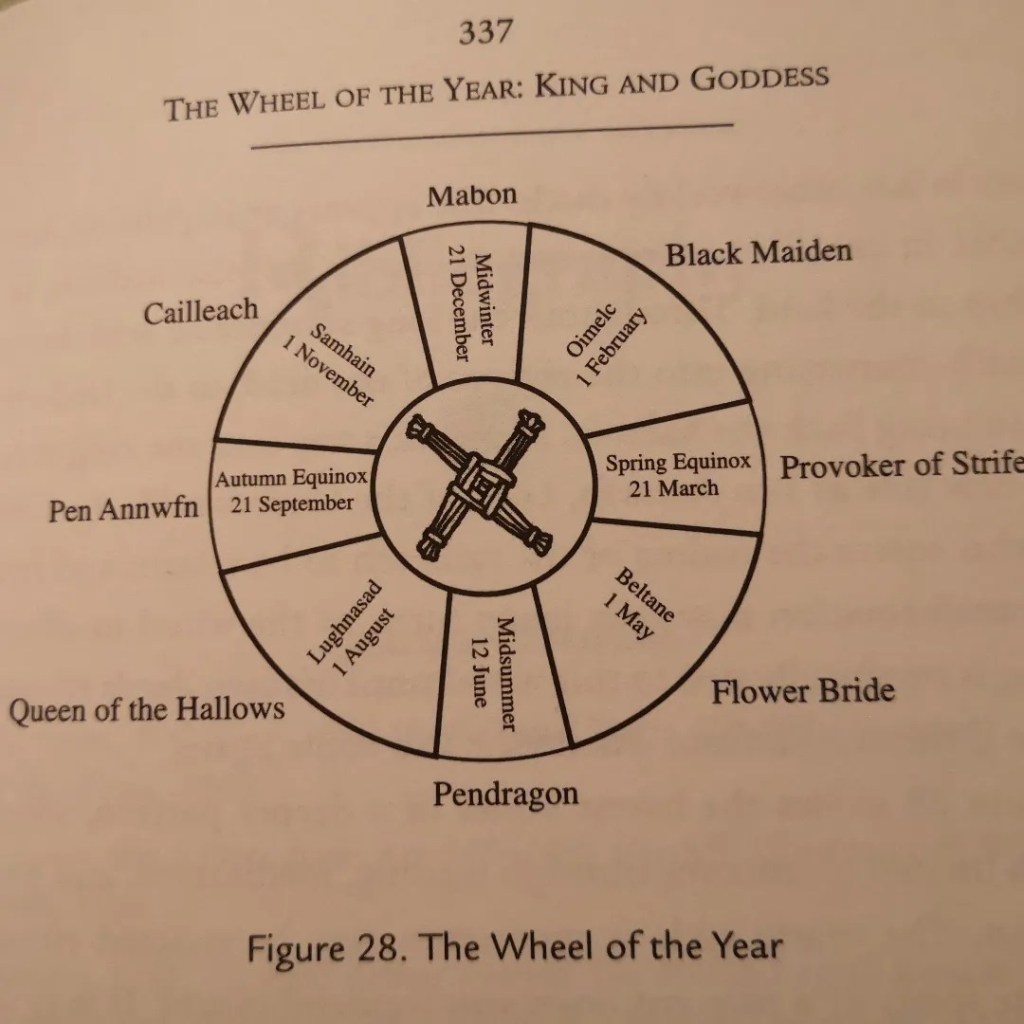
Sexuality is something I don’t think our culture has ever been able to ‘get right’. The pendulum never settles nicely in the middle. Instead, the ideal woman is either a chaste Madonna or a wild Whore with no sexual boundaries. Sex before marriage makes you tainted and impure (especially if you’re a woman) or it’s a requirement to be as sexually open as possible if you want to find a partner and those who don’t are shamed as prudes. Either the only acceptable way to have sex is a married, heterosexual couple doing missionary once a month with the lights off until the man finishes and the woman lies there unsatisfied OR all kinks and fetishes, even the most dangerous and degrading ones, are seen as utterly exempt from criticism and teenage girls end up hospitalized trying to do things their boyfriends have seen in hardcore porn. Either we’re never allowed to talk about or acknowledge sex or we can scarcely turn on our televisions without seeing pornography. I believe Sacred Sexuality is the cure for this, the one view of sexuality we’ve never truly tried in our culture, either demonising sex or forcing it down everyone’s throats to the point where it looses all its meaning. But our bodies are holy and pleasure is our birthright. Sacred sexuality occurs when we truly treat sex with the reverence it deserves, as a spiritual sacrament, and you see the God or the Goddess in your partner. In heterosexual relationships, this comes in the form of union of opposites, Chalice/Grail and Blade/Wand, God and Goddess, King and Queen. At a time when gender relations are so rife with tension and an almost sibling rivalry type of energy, when women, deeply hurt by misogyny, declare men are useless trash who don’t need to exist and men declare that women should submit and be led by men, I believe union between the masculine & the feminine are needed now more than ever, not as competitors battling for dominance, neither one submitting to or domineering over the other, but two equally valuable and potent forces that stand side by side. But homosexual relationships are no less sacred, and metaphysically they can be explained as Source returning to Source, and there are various pagan traditions that celebrate gay love though on the surface I can see why it may seem like all this talk of union between masculine & feminine at Beltane means gay love is less worthy. I want to assure you that as a bisexual woman and someone who thought I was a lesbian for many years, that’s not the case. For lesbians, I suggest looking in to the Dianic tradition and to Artemisian and Sapphic sexual mysteries, and to gay men I point you towards the Feri tradition, which I believe deeply celebrates love between men.
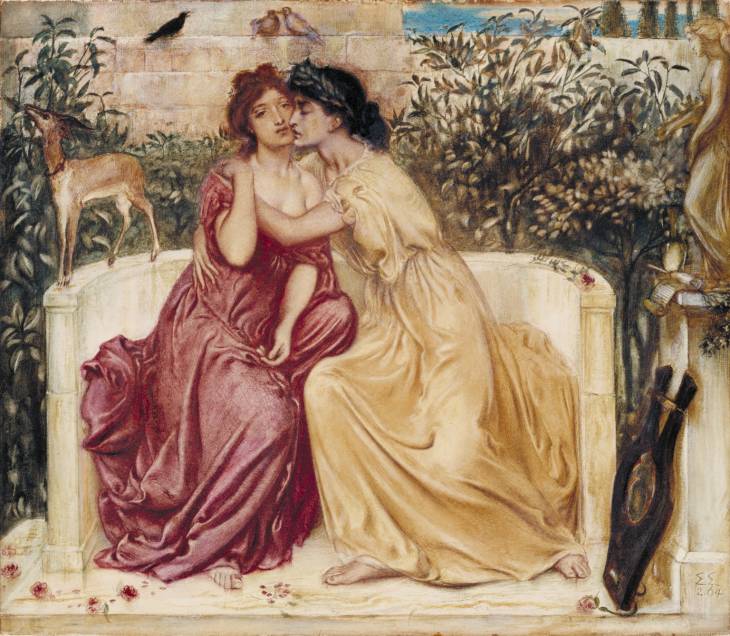
Last month in my moot, I gave my talk about the Flower Bride and the King of the Land, which was my first time giving a full talk on a pagan topic. Before that, we performed a small ritual in which I was the May Queen/Flower Bride & the embodiment of the Goddess, whereas the amazing Kev was our Green Man/Jack-in-the-Green/Oak King/God. I was so so nervous about that talk but everyone loved it and gave me such positive feedback. Interesting that based on our ages and genders we have Holly King, Oak King, Maiden, Mother & Crone here, as Jan remarked!

On May Day itself, which obviously is a bank holiday (another reason why Beltane is my favourite of the Wheel festivals!) I hosted a pagan gathering for the first time. We performed a simple ritual, I told the story of Rhiannon & Pwyll, exchanged gifts, made flower crowns, ate picnic food, sang songs, did some spellwork & just enjoyed each other’s company in a little grove we found right next to a hawthorne tree/May bush, which we didn’t even realise until we sat down. It was genuinely one of the best days I’ve had so far this year and I’m so grateful to everyone who came. I almost cancelled so many times because I didn’t think anyone would come. I’m manifesting, praying & hoping for more of this in my life.


Before I finish off with a bibliography of reading I’ve done last month and prior to that relating to these topics, I want to leave you with two poems I’ve written about Beltane. One was written last year and partially inspired by my former muse, my ex boyfriend, who is no longer in my life, but I am still thankful for what he did for me and the way he showed me what requited, healthy love feels like, and I see no reason why I would have to discard the whole poem when its themes are universal. The other was written specifically with the theme of the Goddess choosing Her God/the May Queen choosing the May King in mind, and I read it aloud at both Beltane events mentioned above. In this latter one I really wanted to acknowledge the Lover archetype between Maiden and Mother, the archetype honored by the Glastonbury Avalonian tradition at Beltane.
Sound the trumpets, blow the horns!
She shall be a maiden no more.
Light the fires, call the dance! She meets her paramour.Dressed in crimson, dressed in white,
Their innocence, their love.
From their union comes the light,
The Firebird and the Dove.He is hers and she is his,
They leap over the flames.
Kiss me now, touch me there,
Begin the fun and games.She makes him king, he crowns her queen,
Sovereignty through desire.
The Lady and the Horned One’s love
Forged in Beltane’s fire.
She whose body is the land
And rules with a flower sceptre
Initiatrix-Queen of Kingship
Calls only he who is worthy
To join her in divine sovereignty
And as her hero kneels before her
She lays an antlered crown upon his head
And leads him to his throne
Then he, newly crowned Solar King
Her chosen Champion
Unmatched in power, passion and potency
Awakens her potential through his touch
And soon her belly will swell
And her blossoms will be transformed
Into the most succulent of fruits
But for now, tonight, it’s just them
Young and wild king and queen
And the roaring fires of Beltane
In which they stand in the liminality
Between Maiden and Mother
Between Youth and Father
We say Hail to the Summer
And to the Sovereign LoversAs promised, here’s some reading if you want to learn more about the Flower Bride/Sovereignty Goddess and Her King.
- Blodeuwedd: Welsh Goddess of Seasonal Sovereignty by Jhenah Telyndru
- Rhannon: Divine Queen of the Celtic Britons by Jhenah Telyndru
- Flower Face: A Devotional Anthology in Honor of Blodeuwedd by Ninth Wave Press
- King Arthur & the Goddess of the Land by Caitlin Matthews
- Ladies of the Lake by Caitlin & John Matthews
- Once & Future Queen by Nicole Evelina
- Priestess of Avalon, Priestess of the Goddess by Kathy Jones

Sorry, one last thing, then I promise that’s it! Here is my Beltane playlist, featuring mostly pagan songs with a sprinkling of Taylor Swift, because it wouldn’t be a Rhianwen playlist without at least one Taylor Swift song (convert to paganism, Taylor, please, the Christian conspiracy theorists already all think you’re an actual witch!)
The actual/seasonal astrological date for Beltane is tomorrow, so regardless of when you celebrate I hope you all have/have had a wonderful Beltane/Calan Mai/May Day/Floralia etc. May your summer be full of love, sunshine, optimism & magic.
Rhianwen
avalon, avalonian, avalonian tradition, beltaine, beltane, blodeuwedd, brythonic polytheism, celtic polytheism, creiddylad, divine feminine, divine masculine, flower bride, goddess, goddess religion, goddess spirituality, goddess worship, gwenhwyfar, king of the land, paganism, rhiannon, sovereignty, sovereignty goddess -
Ostara/Eostre: Hail to the Goddess of the Dawn & Spring
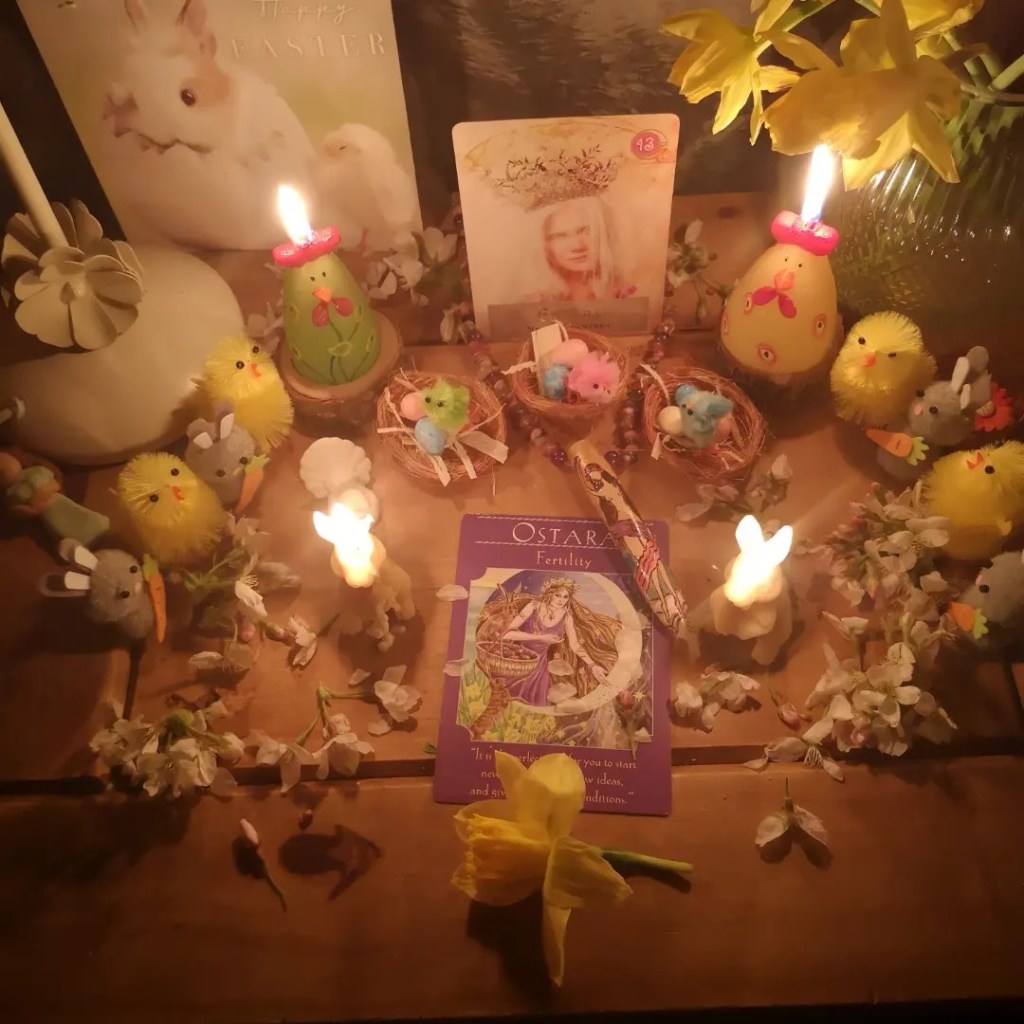
My Ostara altar So, last week, we who follow the modern Celtic-Anglo-Germanic Wheel of the Year with its equinoxes, solstices and four Celtic cross quarterly festivals celebrated Ostara last week. Ostara has always been one of my favourites in the Wheel, and when I was a Christian I always loved Easter. Every year when we were little, my mum would make us these Easter bonnets for school, with daffodils and chicks and pastel eggs all over them. I love the aesthetics and imagery of this time of year, and how we finally emerge fully from the Descent period, ready to climb up the mountain of Summer that reaches its peak at Summer Solstice.
My mood has been up and down. I think I truly believed that by the time spring rolled around I’d be over my breakup and be going on dates, ideally with the same partner with view to exclusivity. Instead, my love life is still nonexistent despite my best efforts at using dating apps and websites, speed dating, joining new social groups to meet likeminded people, etc. Last year, it seemed like everything in my life was so perfectly aligned with the seasons, especially my love life, in which I went on a first date around Ostara with the man who would end up becoming my first love, and then the two of us made things official around Beltane, and so on. While I still have a bit of time to recreate that pattern, I don’t want to set my hopes too high because unfortunately, life doesn’t always follow the reliable, ordered patterns of Nature, especially not when other people are involved. So, I’m doing everything I can to find happiness and contentment without the need for another partner. The fear I have is that while it’s okay that I’m single now, I’m vastly approaching my thirties and am terrified of the drop in my fertility that will accelerate each year from now on.
But I’m trying not to think about it (not easy) and just focus on the wonderful, magical experiences I’ll get to have this spring and summer by myself and with friends. At this point my approach is just ‘fake it until you make it’ and pray that eventually, all the things I’m doing to try and trick my brain in to being happy will eventually work. For some reason every time spring rolls around, my social life tends to take off. I have a few concerts, parties and things coming up, and of course, I’m excited about my annual visits to our little women’s gathering in Wales and my yearly pilgrimage to Glastonbury-Avalon, my spiritual home.
I wanted to talk a little about how I understand Ostara, because there’s a lot of conflicting information out there around it. Following on from that I wanted to do some comparative analysis to the story and character archetypes in the story of Sleeping Beauty. There are many deities associated with this time of year, but I’m going to choose a handful of ones that are relevant to my practice and understanding of spiritual metaphysics.
Astrological New Year
The Spring Equinox is the astrological new year, when the Sun enters Aries, celebrated in Babylon as the day light emerges from the darkness as the warrior god Marduk defeats the Creatrix dragon goddess, Tiamat, and reforms the world. Some believe this to represent the defeat of the matriarchal order by the patriarchal order, some believe it to represent us learning how to make sense out of nature via agriculture and scientific progress, other believe its a mix of the two. As a Mother Goddess worshipper, I’m not a fan of this story and the understanding it has given so many that the Mother Goddess is a malevolent force of chaos that must be conquered and dominated (cough Jordan Peterson cough) but in terms of its connection to the astrological new year, I thought it was worth mentioning.
Dying & Resurrecting Son-Gods
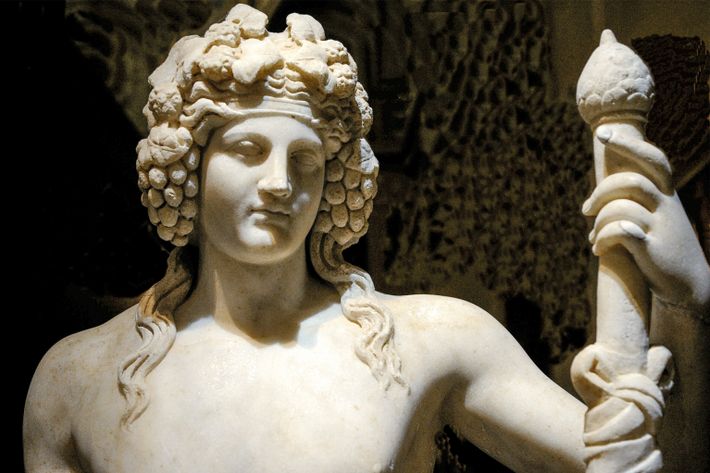
One of the main motifs we see is the resurrection of the god of vegetation, the King of the Land. This is one of two ‘Son God’ variants we tend to see across the world. He is the Son, Lover, or sometimes both of the Earth Goddess. The first one is associated with the sun, and is often reborn (sometimes, but not always, as a baby) on Winter Solstice. Examples of this include Mithras, Sol Invictus, etc. The latter ‘Son God’ is more rooted in the Earth, than the sun, and his body is linked with the vegetation itself. This god tends to be reborn on Spring Equinox. Examples of this include Attis, Osiris, Dionysus, etc. I prefer this version of the archetype over the former because I don’t like this earth feminine/solar masculine split we see fairly often in new age spaces, just doesn’t feel right within my soul. Whether it be the Vegetation God or the Sun God, it’s not hard to see parallels between this and the birth, death and resurrection of Jesus Christ, leading many to speculate that there may be a link. It is possible that this theme of death and rebirth is simply an eternal truth that is so instinctual that we have told the same story over and over again, rather than Christians simply taking the idea from earlier pagan mystery cults. One thing to keep in mind is in both of these myths, the Goddess is the unchanging, primordial force (which is almost the reverse of the solar masculine/lunar feminine idea). The Sun arises from the Earth when it comes over the horizon, or from the darkness (most spiritual systems believe darkness came before light). The Vegetation, which is constantly grown and then reaped and replanted, arises from the Earth, the ever-present soil. This does not make the Son subservient to the Mother, He grows to be Her equal in all things and is just as necessary as She is to the Cosmic Order, but it is a humbling reminder to all of patriarchy’s most ardent defenders that all life comes from the Divine Feminine. Perhaps that is why Abrahamic tradition subverts this, and to this day, those religions are the only ones to do so, as far as I know. Even patriarchal pagan religions knew that the masculine arises from the primordial feminine.
The Divine Daughter

While there is no official date given for the return of Kore/Persephone to her mother Demeter in the myth, it is fair to assume it is Spring Equinox. I always felt like Dionysus and Persephone were parallels, and while the Orphic tradition mainly worshiped Dionysus’ resurrection, I believe they honoured Persephone’s emergence from the Underworld, too. While Inanna-Ishtar is not related to this time of year (despite viral misinformation claiming so), I feel like many people within the Goddess tradition, syncretists, comparative mythologists etc intrinsically understand Inanna, Persephone, and similar goddesses who descend in to hell and then return to be the parallel Divine Daughter archetype to the Divine Son mentioned above. Whereas the Son dies and is reborn, the Daughter descends and ascends (much like Venus, the Morning Star). Some researchers claim that the Mother-Daughter/Maid Dyad is older yet than the Mother-Son Dyad, and that the Demeter and Persephone story is merely one of the few Mother-Daughter myths that carried through to patriarchal Hellenic religion from an older, more matriarchal belief system (potentially from Crete). Unfortunately I do not have any citations for you at this moment but it’s something I’ve seen mentioned a few times in books. For years I was part of a tradition called Filianism in which this Dyad (as well as the feminine trinity of Mother, Daughter and Absolute Deity, similar to Maiden-Mother-Crone) was the core focus of the mythos and metaphysics. Eastre (Ostara) was the day in which the Daughter (known as Inanna, Anna, Jana, or Kore) is resurrected by the love of the Mother (Marya, Mari) and reigns as Princess of the World, ready to be crowned Queen of Heaven at Exaltia (Beltane). While I have moved away from this tradition for a couple of different reasons, their syncretic approach to this Divine Daughter archetype truly moves me, because I believe Her erasure in our traditions to be such a missed opportunity. If Patriarchy seeks to separate the Son from the Mother, it DEFINITELY seeks to separate the Daughter from the Mother, and as women, reconnecting to our Mother-Line and female ancestresses is so important to our goal in relighting the flame of the divine feminine in the modern world.

The Light of the Dawn

I did mention this in some detail in my Imbolc post, but it is actually more relevant here than it was there. One of the oldest goddesses whose worship, correspondences etc we know about is the Dawn Goddess. Usually the Daughter of the Sky Father, the awoken the world from its slumber at morning, and was also associated with spring. Like I said in my Imbolc post, if the year was a day, Spring Equinox would be the glorious dawn when the sky is ablaze with glorious gradients of pink, lavender, orange and blue. While the sun is usually considered masculine in modern Neopagan syncretism, many syncretists would be hard pressed to argue that the dawn doesn’t bring to mind a beautiful solar maiden. She has many names across the Indo-European sphere: Eos, Thesan, Mater Matuta, Aurora, Ausrine, Ushas, some even theorize a link to Aphrodite, but for our purposes, as this is holiday in a Wheel of holidays based on syncretised Celtic and Germanic roots, we are focusing her under the name of Ostara (Germanic) or Eostre (Anglo-Saxon), beautiful spring maiden who loves all things fresh, innocent, and new. It is frustrating to see misinformation on two opposite sides of the spectrum that claims She is either definitely a modern, new age invention, or that the Christians stole absolutely everything from Ostara/Eostre which also isn’t true. Or worse, the belief that somehow Easter derives from Ishtar. The facts: We know beyond a shadow of doubt that Hewsos, the Dawn Goddess, had several variations as the Indo Europeans conquered various territories and bought their gods with them. It stands to reason that Eostre and Ostara would be linguistically connected with these, and while Bede was the only one to mention Her, there’s little reason to suspect he was lying, just that many of these practices and beliefs were oral traditions only. This is by far one of the best articles about this topic I’ve read.
While many bad faith so-called ‘feminist’ interpretations of the fairytale Sleeping Beauty have been written over the years about how it tells the story of a man sexually assaulting an unconscious woman, the story is arguably a parable for the return of spring. The Divine Daughter is born to the King and Queen. The wicked fairy represents the Queen of Winter, of the Unseelie Court. The royal family attempted to shut her out of their homes, but they can not deny her for long. As much as they like to deny it, they are not too civilized and protected that Winter won’t come to them (compare to the Green Knight disturbing the festivities at King Arthur’s New Year’s Eve party). The baby is cursed by the Queen of Winter to die upon reaching the full stature of maidenhood. The curse is altered by three good fairies of the Summer Seelie Court, who ensure that she does not die but is simply in a slumber but can be awoken if she receives true love’s kiss- representing that due to divine providence, the very natural order of things, winter will always come to pass. She grows up fair, graceful and good, and meets a young man with whom she falls instantly in love with (I don’t want to hear your yapping about how unrealistic it is- it’s a fairy story!). Soon after this her curse catches up to her and she dies upon pricking her finger on the spindle of a spinning wheel. But her prince, as promised by the fairies, is able to awaken her with a kiss. Now, I can hear the ‘UM ACTUALLYs’ about to tell me that she was actually raped by the prince, but that version of the tale belongs to a version called Sun, Moon and Talia by Giambattista Basile and is not, as far as we know, present in every version of the earliest oral tradition. There are many, many versions of these fairy stories and trying to say one way or another which is ‘the true one’ is a waste of time, but there’s no evidence Basile’s version represents the ‘original story’ as many pseudo-intellectuals claim. Now, there is still room for some feminist analysis here- why is the solar Daughter principle made in to a passive Earth allegory in Her story instead of awakening the land in Her golden chariot as She actually does in Nature and mythology, for instance? But, overall, it’s not something I worry about because I’m just happy that, once again, the Goddess hides in plain sight in our fairytales and folklore. Plus, technically it was the good fairies that saved her, not the prince, seeing as they made the prince’s rescue mission possible to begin with! Just like how the prince is credited for saving Cinderella when, if anyone did, it was her Fairy Godmother (the Crone who initiates the Maiden, allowing her to step in to her power).
I don’t think it’s a coincidence that Disney chose to name their version of Sleeping Beauty ‘Aurora’, a name of the Dawn Goddess (although perhaps this name was found in an earlier version of the story- I’m unsure). Even her dress has variants in both pink and soft blue, reflecting the colours of the sky at dawn.

I have experienced the Dawn Goddess so strongly for years. Since I was a little girl obsessed with Greek mythology, in fact, and came across a picture of Eos with her ruddy wings and hair and fell in love. She became somewhat an imaginary friend of mine and it’s crazy to me that two decades later She is still such a massive part of my life. I have this Barbie, Morning Sun Barbie, who very clearly represents this Auroran Goddess archetype and sits on one of my shelves. I do not consider this an altar and I do not use the doll for worship purposes but I have to admit I do smile at her, blow her a kiss or simply touch the hem of her gown before I leave the house sometimes.
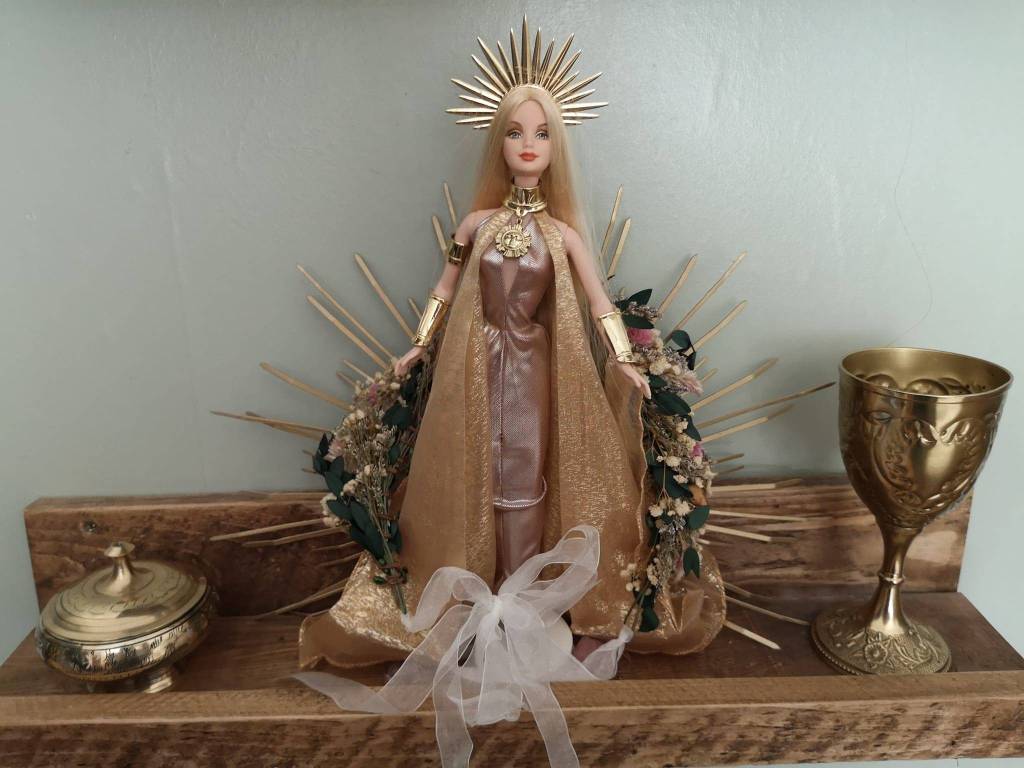
Lastly, here’s a link to my Ostara playlist. I want to make these for every Wheel festival from now onward.
Things still kind of suck for me right now, and maybe they do for you, too. But we don’t know what’s around the corner. Life comes at you fast and can change at any minute. Congratulations on getting through the winter, and I wish you nothing but happiness and joy as we begin our ascent to the Summer Equinox. Love you all.
~ Rhianwen
-
Kali: Holy Slayer of Demons or Chaotic Devouring Mother?

Kali by V. V. Tapar O human mind, throughout your thinking process invoke the subtle sound of Kali, Kali, Kali. Why not ground your entire being in Her Holy Name, which dissolves all dangers arising from without and from within?
How can you forget, even for an instant, Her supremely precious Name? The mind that remembers the Mother experiences no fear when facing the terrible expanse of universal suffering.
Overcome with fervent love, this poet pleads: “O mind, how can you possibly forget the Mother? At the very center of your being sing ceaselessly the Name of Kali, for your life in the current of time is coming to an end.”
Ramprasad poem No. 21, translated by Lex Hixon, featured on the Shakti Bhajans album by Jai Ma Music.I am writing this on my phone, stood under a bus shelter, because I wanted to get this out but will be busy tonight and will need to go straight to bed as soon as I get home.
Jordan Peterson is having some sort of mental breakdown in which he thinks worshippers of Gaia, Pan, and now the Hindu goddess Kali are on some rampage to destroy the West. Most recently he made some downright genuinely offensive comments about the goddess Kali, for which he not only refused to apologise and admit his mistake, but doubled down upon when challenged on it by Hindus, the overwhelming majority of whom were very polite about it.



(Note: I’ve chosen to censor that bottom one because it uses what I perceive to be a homophobic slur, and it’s getting in to sociopolitical issues that I’m not at liberty to comment on right now). I genuinely think this man is suffering from a form of spiritual psychosis and he’s seemed more… Troubled than usual since his coma and benzo addiction.
I’ve said a lot about my dislike for this man’s views and politics (especially around the feminine and the environment) but I also think there’s something to be said for how his earlier work has genuinely benefited a lot of young men’s lives. I don’t like to demonize people I disagree with and with some notable exceptions I can see the good in many different psychologists, theologians and philosophers whose work I personally don’t like. To be honest, while I’ve not read his books other than a flick through my ex’s copy, some of his earlier interviews and lectures have genuinely helped me adopt a stronger mindset and ‘get my act together’ so to speak. I think he spoke to a dadless generation and as someone with little to no masculine influence in my life, I get it. He is certainly a better role model for young men than some so-called ‘masculinity gurus’ that have risen (and fell) in recent years.
But this is ridiculous. Pagan gods and Hindu gods are not malevolent archetypes of chaos that want to attack Western values. On the contrary, Indo-European polytheism is the basis of Western civilization. Who are the last mainstream, far-practiced IE religion left on earth? Hindus. Whom I have so much respect for.
Even his most ardent defenders, if they have a shred of intellectual honesty, should admit that this is a bad look. No one is forcing college students to worship a Hindu goddess (and environmentalists aren’t forcing Christians to worship a Pan or Gaia).
He has also taken a very Christian centric approach in which masculinity = order and femininity = chaos. Inasmuch as we can appreciate Chaos as a force of change, intuition, flow, power that cannot be dominated by any human, beauty, love, I have no problem with that, but you can’t apply it to religions where it does not fit. Kali Maa is not a force of chaos. Her name means ‘time’. She is a fierce defender of the divine order, slaying those demons who threaten her children. She is much more akin to Jesus or Our Lady Mary in Christianity than Lilith or Tiamat. And it is pretty clear to me that Peterson has a deep fear of what he perceives as ‘feminine chaos’, instead of an understanding that it is an equally necessary, equally capable of good force as order is. You need a balance of order and chaos. Peterson is very influenced by the likes of Jung- and somewhat by Joseph Campbell, who spoke fondly of the Goddess, the Earth Mother, and so forth. Campbell never disparaged Her as a dangerous, chaotic, idolatrous force. There are those who have told me Peterson is not a Christian supremacist and is okay with pagan religions but at least now, that no longer seems to be the case. From what he has been saying lately, perhaps since his full conversion to Christianity (rather than dancing around the subject when asked about his religion like he did for years) it seems he is genuinely anti-pagan and anti-any religion that isn’t Abrahamic, or worships a single, transcendent, masculine-coded God. Many such people look at Kali’s frightening appearance and perceive her as a demon, or at least something she very much isn’t.
This is also why, as somewhat of a Jungian and comparative mythologist myself, we must be careful that we are not applying our own culturally Christian biases to deities whom they do not apply. Many goddesses from not just Hinduism but also IE paganism generally who appear to represent ‘chaos’ on the surface are actually acting in favour of the divine order. Let’s think about this metaphysically for a minute. Many goddess worshippers, Jungians etc agree that the feminine represents nature, matter, the changing seasons, the changing earth. Okay. Do the seasons just come whenever they want? Do you wake up one morning in January and find suddenly it’s late summer and the apples are beginning to fall? Of course not. Nature is deeply ordered. I do not disparage those who, in an attempt to understand our complicated universe and the relationship between the divine feminine and the divine masculine, have came to the conclusion that chaos is feminine. I have friends who take this view. But even in Yin and Yang, which influences this Jungian chaos/order dichotomy, a seed of Yang lives in Yin and vice versa. Therefore, can we not concede that even if the Goddess represents chaos, she employs order to weave the patterns of the seasons?
Kali does not come from the underworld. I assume he is conflating her with figures such as Hekate and Ereshkigal. All broadly fit under the banner of ‘dark goddess’ but there’s a lot of nuance that gets missed in these modern conversations about polytheism. Archetypes can be useful to understand how the gods influence our lives but they are not the be-all-and-end-all. The ‘Devouring Mother’ Peterson speaks of is a Jungian archetype that influences mothers who are overprotective of their children. It seeks to prevent children from reaching their fullest potential at its most benign by stifling their development (picture the mother who won’t let her son skateboard with the other boys in case he hurts himself) and at its most damaging it is abusive and narcissistic. I’ve certainly seen this archetype influence mothers I know (including one significant one who does not like her adult sons having serious girlfriends or making decisions without her approval). It can be understood in terms of figures like Mother Gothel from Rapunzel.
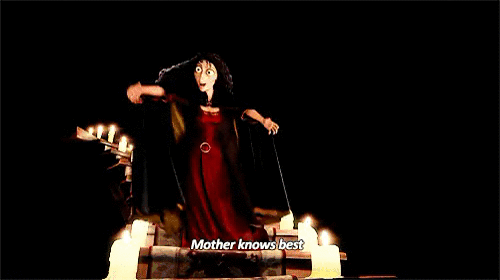
But Kali Maa is not an example of this archetype. As for ‘the Goddess’ in the sense that many modern Westerners use it, She is all, and can be said to contain this archetype within Her, but Christian, and culturally Christian patriarchal men like Peterson hyperfixate on archetypes such as this as if that’s all the Goddess is, implying She is a threat to Western values (when actually Her civilization arguably influenced much of ours). I’m also not sure how he came to the conclusion that the Devouring Mother is influencing academia but I’d genuinely be interested to know why he thinks this. Perhaps he’s saying she prevents professors from allowing students to reach their own conclusions on topics and instead wants them close to her ideas? I’ve heard that about academia before, but to be honest, while the series of tweets seems like mostly incoherent psychobabble to me (as do most of his tweets of late), it seems to be more that he’s associating her with leftist ideologies such as feminism. Which brings me to my final point.
While Paganism and especially goddess worship have became very politicized due to their association with environmentalism, equality and feminism, you don’t have to identify as a feminist or any political ideology to come to Her. Her worship transcends human bi-partisan issues. While I’m basically a leftist (and some spicy flavour of feminist, depending on who you ask) myself, I think it would be great if the Goddess could be separated from these issues and depoliticised. I know that’s not going to be a popular take and I understand the argument that the Goddess calls us to embrace ideas of equity, balance, empowerment of the oppressed, protection of the planet and so on. I very much agree, but people have different ideas on how to do that, so rather than saying, for example, ‘you have to identify as a feminist to worship the Goddess’ I’d prefer if we could say ‘the Goddess teaches us that women are of equal value to men and deserving of protection, dignity and respect’. Associating the Goddess (and paganism generally) too heavily with leftist politics also lends credence to the idea our religious views are not sincere and instead we’re just using them as political tools.
I would ask you all to go listen to what Hindus have to say on the topic of Kali rather than doing what many tend to do in the Western, Jungian-influenced Goddess movement and paying more attention to non-Hindu, culturally Christian sources on Her. I saw many well-worded, intelligent, beautiful responses in response to Peterson’s tweets from Hindus across the political spectrum.
Jai Maa.
~ Rhianwen
-
Imbolc: The Predawn of the Year
So, I know what you’re thinking. “Rhianwen/Erin, Imbolc was five days ago! You’re late!”
To which I would say, technically it depends which calendar you’re following, and secondly, I’ve been so busy! And in fact, I’m not even mad that I’m only getting this blog post out now, because today marks the official end of my Imbolc observance, so I didn’t want to make this post prematurely and have make another one.
I had wanted to start a new blog for a while, but the depths of winter did not feel like the right time. After an amazing summer last year, as soon as we hit mid September I was called once again like many of us on the Venusian path are to descend like Inanna in to the depths of my own personal underworld after my relationship, which was still very much in the honeymoon period, ended abruptly, coldly and without any forewarning. I spent most of this winter lying in bed, dreaming, reading, journaling, just trying to process the pain I was experiencing. Trying to move through it with grace and beauty like Queen Rhiannon, but also wanting to howl and screech and grow claws and fangs like a werewolf and tear everything apart. That was absolutely not the time to be starting a new blog. But Imbolc? Couldn’t be more perfect.
Whilst most contemporary Celtic-focused polytheists hold the Celtic new year to begin at Samhain, I cannot bring myself to resonate with that. For a while I have struggled to find the balance between my belief that spiritual cohesion and shared truths are important, but also not trying to force myself in to a paradigm that does not fit me. I needed the start of my year to be about newness, freshness, life, not descent and death. When I was a Filianist, we celebrated the new year at Spring Equinox (Eostre/Ostara). That always felt more fitting to me, and still does. In fact, I am torn between either Imbolc or Ostara as the new year in my personal wheel observance. I could be mistaken, but from what I understand, the Dianic tradition honours Imbolc as the New Year. Either way, I realised that if Ostara is the dawn, where we honor the Indo-European dawn/spring goddess and all Her cognates, Imbolc is the pre-dawn. When the sky is still navy blue, but you can see the sun’s light just slightly beginning to creep in, like this photo:

Brigid is, in one sense, a Dawn Goddess, much like the goddess Ostara/Eostre who are thought to be associated with Her (I will post more about this at Ostara itself). The IE Dawn Goddess (H₂éwsōs) is one of the oldest forms of Goddess we have concrete evidence for, up there with the Sky Father and Earth Mother. Brigid’s name is cognate with “the Sanskrit word Bṛhatī meaning “high”, an epithet of the Vedic Hindu dawn goddess Ushas. We know that Brigid’s name means ‘the High One’ or the ‘Exalted One’, and that early Hindu gods share some interesting similarities with Irish ones (see Danu, the same goddess thousands of miles apart). Therefore, like Ushas, Eos, Aurora, Ausrine Eostre, Ostara, Thesan, Mater Matuta etc, Brigid may be related to H₂éwsōs, but her Dawn Goddess aspects seem less apparent than with those other goddesses and what survived Christianisation (through Her relegation to a Catholic Saint) the most were her other aspects, particularly those associated with healing
She is ‘the goddess the poets adored’, and the spark of inspiration to begin new projects this time of year. But it is a gentle spark, and so in my desire to live in harmony with the cycles of nature I am trying to restrain myself from pushing myself too hard just yet when I am still feeling the dormancy of winter, and not yet fully out of my Descent period. That being said, I have started a new job, written the first chapter of my book, and started a course for work. Brigid’s energy has been the instigator in all of this. With Her wand, she gently awakens the land, and with that, all of us. It is a testament to how beloved this Goddess was that She not only survived Christianisation but remained one of the most beloved saints in Ireland, up there with St. Patrick. As of this year, St. Brigid’s day will be celebrated in Ireland as a bank holiday on February 6th. Like many saints, She is a bridge (fitting, given her name) between the Old Ways and the New. She was known not just in Ireland, but also in Scotland, England and Wales. In England, She was also known as Brigantia, the sovereignty/pastoral goddess of the Brigantes. Another fascinating thing is that while she has a consort and sons, She is the primary ‘character’ in her own Divine Drama, not just a mother of a divine son or wife of a divine father. We do not need to reclaim Brigid from patriarchy like we’ve had to do with some other goddesses. She always represented a sovereign matriarchal/matrifocal way of being, which is probably why she is one of the most primary goddesses in the feminist goddess movement.
I won’t dive too deeply in to Brigid’s mythology and correspondences outside of what I’ve already said. The point of me mentioning the Dawn Goddess aspects were because I feel as though it is an aspect of Her personality that is often overlooked, especially in an age when ‘the divine feminine’ is so strongly associated with the moon largely due to the influence of Wicca, the New Age movement and the desire to use comparative mythology to form a cohesive framework for a modern day pagan practice, also known as syncretism (which I do to some degree because I think it is somewhat necessary at times, but I find it sad it has erased the individuality of many of our native gods and goddesses in favor of fitting one binary formula). The other point was to show that while we’re not fully standing in the radiant, triumphant golden light of the dawn, her ‘cousin’ Eostre/Ostara right now, we’re almost there, and many of us may feel ourselves beginning to awaken once more. Brigid paves the way for Eostre to ride Her chariot across the sky. She is the light just beginning to rise above the horizon, the predawn. She is not the bright flowers and pink blossoms of spring, but the white snowdrop flowers that promise we are almost out of the cold, dark months.
As for how I’ve actually celebrated this beautiful festival and turning point in the wheel: I began celebrating and preparing for Imbolc last Sunday, where I went to the park, sang some songs, looked for materials to make a Brideog and a Brigid’s Cross with (I wasn’t sure what I was looking for and ended up leaving empty handed, so I decided to order some wheat stalks online instead) and looked for signs of the world awakening.
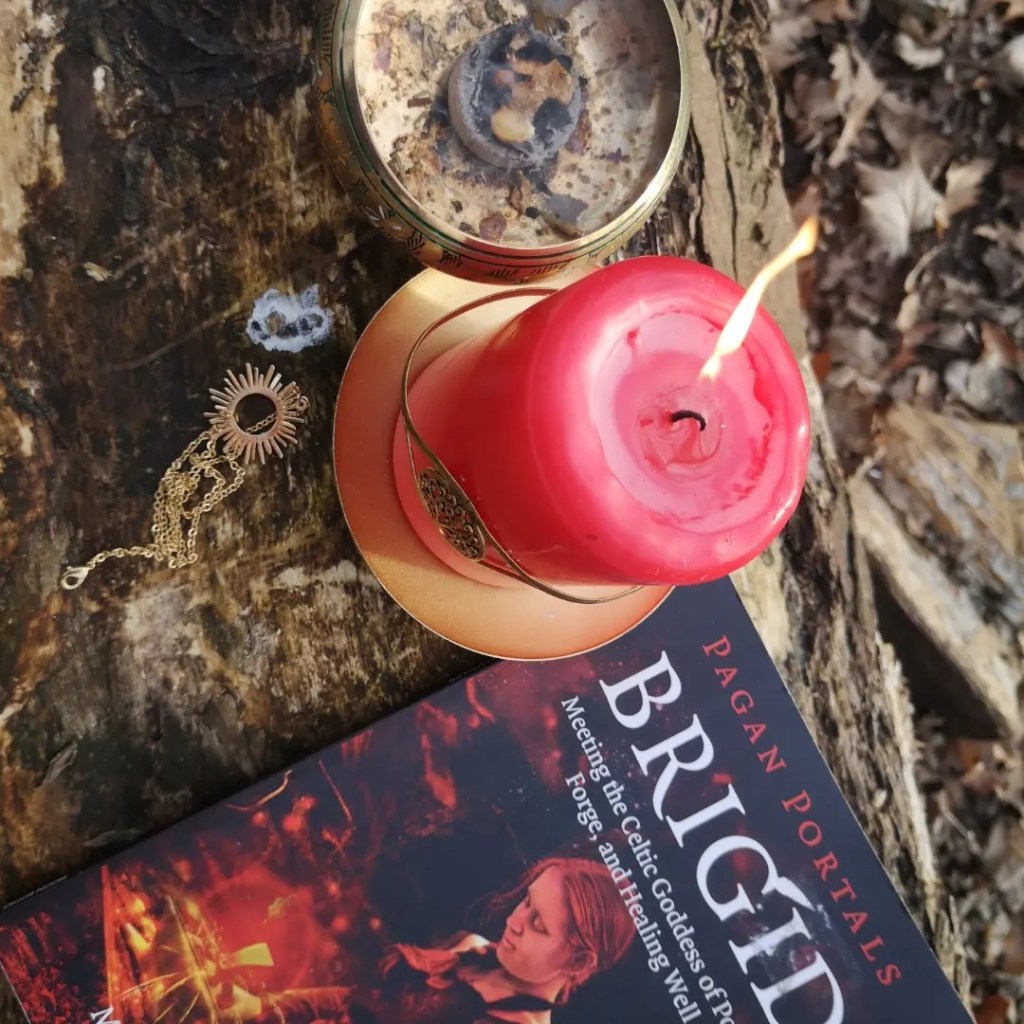

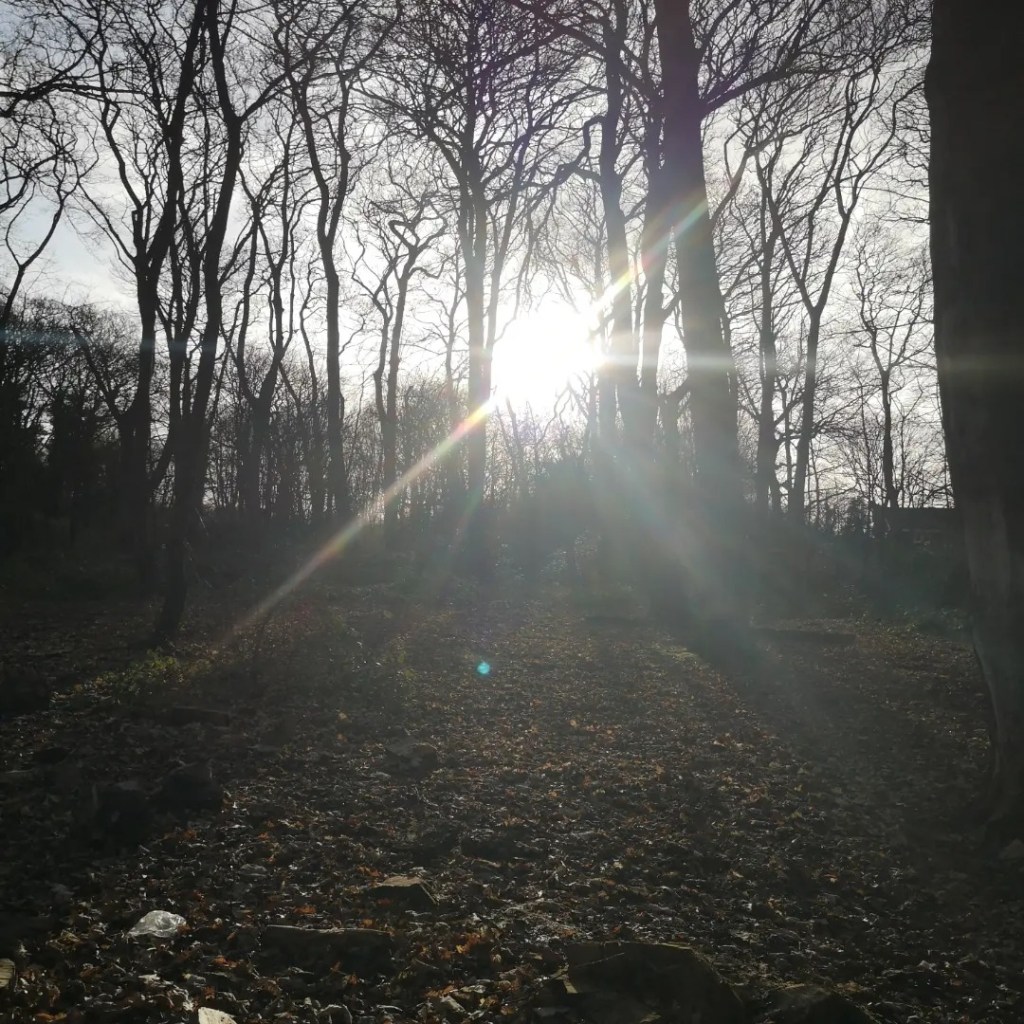
The night before Imbolc itself, after I got back from a different park, I made my Brigid’s Cross, my Brideog (‘little Brigid’ doll), set up my altar, took a cleansing bath, spent some time in prayer and set up a white and gold scarf for Her to bless on Her way by as She awakens the land. I did this last year and found it worked well with headaches and sore throats.

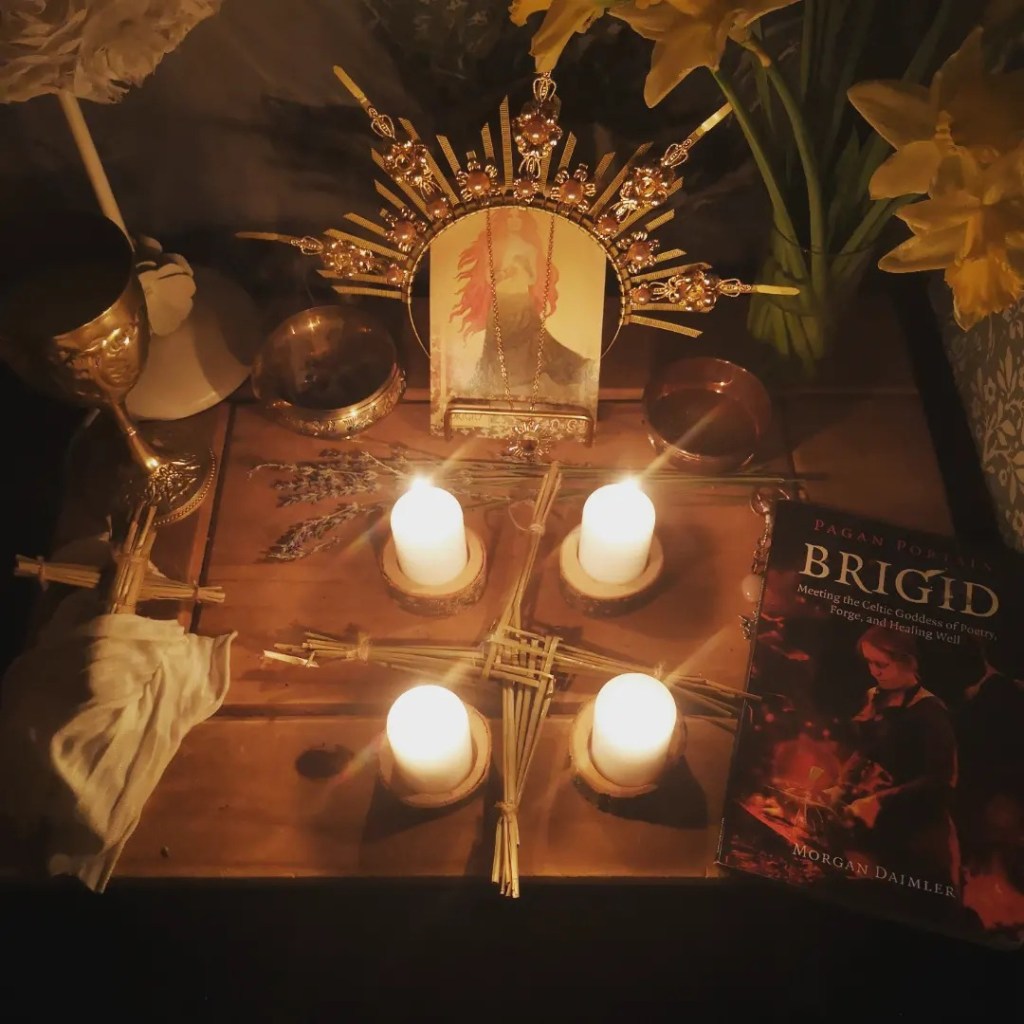

On Imbolc itself, I took part in a beautiful tour hosted by my city’s Irish society in honour of Brigid, where we were showed buildings and sites relevant to Her, and discussed Her many qualities. After this, we went to a spring sacred to Her in the Anglican cathedral gardens, where we all laid out our Brigid’s crosses, and held a sharing circle where we talked about what Brigid and Imbolc mean to us, read poetry and sang songs. I met some wonderful people and couldn’t have asked for a better day.


Lastly, on Sunday night, me and some beautiful sisters went to Wales for an incredible hike, where we sang songs and blessed the parts of the land that had been violated by humans such as destroyed trees and a cockfighting pit. The amount of healing I felt in these moments can’t be understated because it felt like while we were offering our love to the land to apologise and offer healing for the trauma She had faced, the land was sending love and healing back. My favourite moment on the hike was singing Wild Mountain Thyme/Blooming Heather, one of my favourite folk songs, with a sister called Bexi whom I’m convinced is an actual Disney princess. On our way back down, we almost got lost and ended up walking through wild forest where I almost fell over several times, but I didn’t: I think one of the benefits of my path becoming more earth-based and less heaven-based is that I’m learning to trust the Land a lot more to hold me, show me where I need to go, and not let me fall. I swear I’ve been a lot less clumsy lately on my outdoorsy excursions. When we got back to the off-grid retreat centre we were staying in, we ate a beautiful communal meal (I brought veggie curry), held a small ceremony, and spent the rest of the night under the stars and glorious full moon singing songs and talking. We then slept in a lovely little roundhouse, with the fire blazing all night to keep us warm.
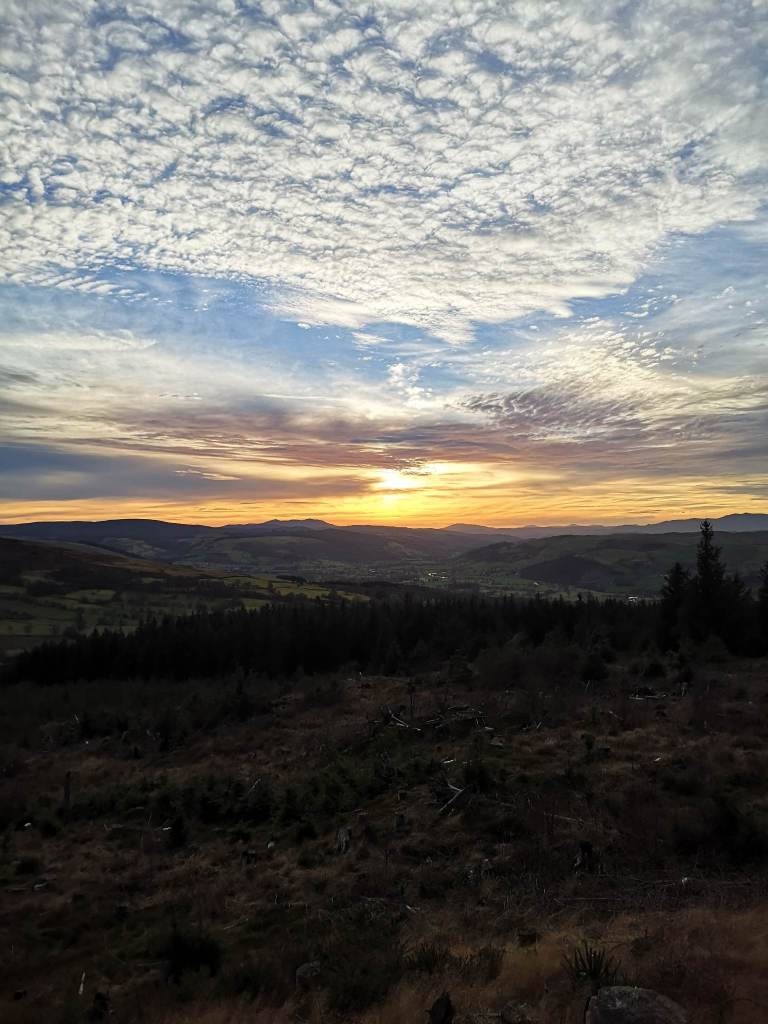


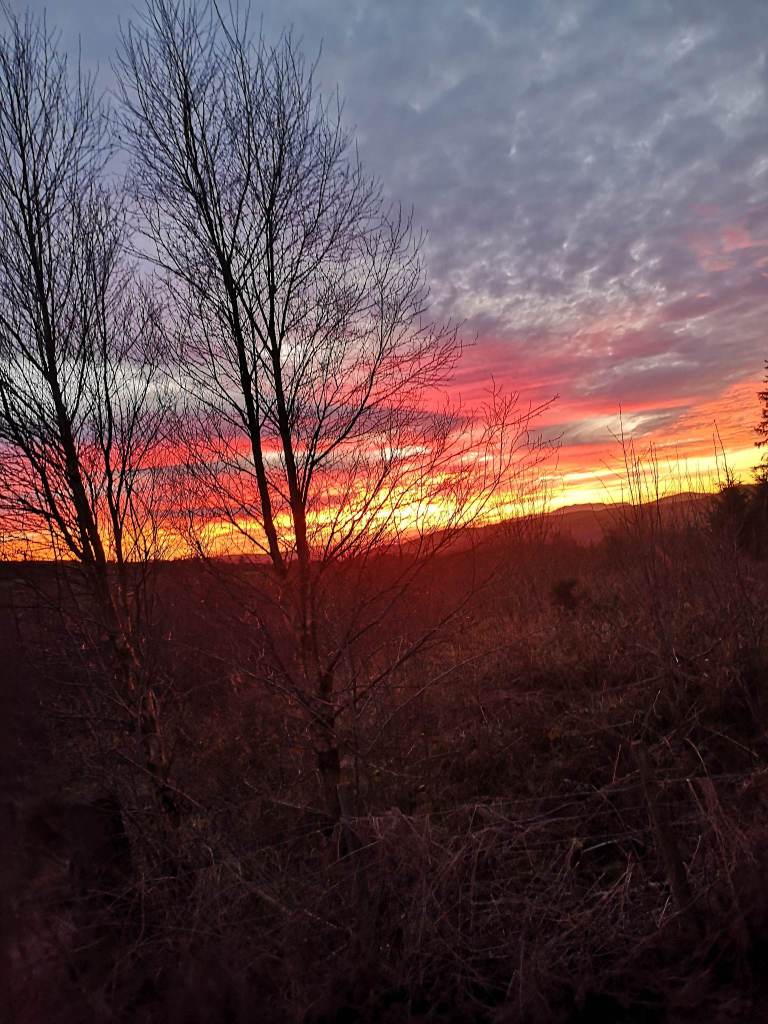
To finish off, I’d like to say that while it’s fun to honour different deities across the Wheel at points that are most associated with them, you don’t have to wait for Imbolc to pray to Brigid and tap in to Her energy. She is always there. Whenever you’re going through a dark night of the soul and need to be reminded that there is light at the end of the tunnel. Whenever you need inspiration to finish a poem, song or story. Whenever you need healing of mind, spirit or body. Whenever you need motivation to spring in to action. I began my journey with Her this time last year, but this Imbolc especially, She has been there for me in a huge way, healing my broken heart and awakening me from my slumber. Please let her be there for you too.
Blessings,
Rhianwen
-
Welcome!
Hello readers, whoever you may be!
This is the fourth blog I have ever began on Goddess religion. The first three, though, were from a time when my approach to it was much different than it is now. As such, I thought it was time for a clean slate. I have learned so much since I made my last blog entry, exactly a year ago today, on my old WordPress site.
For those of you who don’t know me, my name is Erin, but my ‘spiritual’, Goddess-inspired/channeled/given name is Rhianwen Dôn. The name apparently means ‘pure maiden’, but to me is also a combination of two goddesses I adore deeply: Rhiannon and Gwenhwyfar (Guinevere). Rhiannon’s name means ‘Divine Queen’ or ‘Great Queen’, while Gwenhwyfar’s likely means ‘White Enchantress’, ‘White Spirit’, etc. All three of my patron ‘Celtic’ goddesses (I also worship Venus) have associations with the color white. It typically represents maiden-like, gentle, pure, holy energy (though it has a shadow side which I’ll explore in the book I want to write on Gwenhwyfar). Purity doesn’t have to have the connotations many in the Christianized west hold it to have, for purity and innocence are available to any of us at any time, no matter how impure we may feel. The ‘Rhian’ part, the Queen part, is an acknowledgement of my understanding of Divine Sovereignty, particularly in relation to the divine feminine when women have been denied sovereignty in their own right for thousands of years. I’m going to explore that deeply in the book I’m currently writing, but I’m sure it’ll come up in my posts. Finally, my ‘last name’ is Dôn, the Welsh name for the ‘Celtic’ (I am aware this term is a great oversimplification and not historical but just for the purposes of this post please don’t kick up a fuss, I don’t have time to get in to migratory anthropology) Mother of the Gods also known as Dana, Danu, Anu, Ana. I chose the Cymric (Welsh) name because of my Cymric heritage, and an acknowledgement of the role that beautiful land, its stories and goddesses, have played in my spiritual journey since I was a little girl. As someone in the controversial ‘soft polytheistic’ camp, I view Dôn by all Her names as the Celtic manifestation of the Great Mother, who I view as not only an ‘Mother Earth’ figure but also an eternal, celestial force that existed before the physical planet Earth came in to being.
I have always been deeply religious and spiritual. I was raised Anglican, attended evangelical churches for a while, became a Mormon, then went back to evangelicalism for a short time while secretly keeping an altar to Sophia, the hidden divine feminine figure in Christianity. However, it wasn’t enough, I wanted more. I have been walking the path of the Sacred Feminine for about 8 years now. My spiritual path is ever-evolving. I have jumped the fence between a niche goddess tradition known as Filianism, hardline reconstructionism, new ageism, and back again multiple times. I now think it’s fair to say I sit between the revivalist/neopagan and reconstructionist camps; I try to stick to the original, ancient stories as much as possible, while believing it is okay to have our own interpretations and gnosis about them that others may not share. An example is my view of the Brythonic ‘Sovereignty Goddess’ as being a matriarchal concept and not a patriarchal one (again, will get more in to this in my upcoming book), and how I worship beings not typically regarded as goddesses by the hardcore reconstructionists who insist on having indisputable historical proof for everything (Gwenhwyfar, Rhiannon, Morgan le Fay, Olwen, etc).
It also must be said that at this point in my life, despite trying to include worship of the divine masculine/male gods in my practices, I find it hard to do so for I feel very little spiritual resonance there when I try. When I do, it is of Kings of the Land and consorts to my goddesses. I believe this comes from my spiritual upbringing and I do believe that while we still live in a world where 95% of spirituality is patriarchal, it’s not going to tip the scales in to an unbalanced gynarchy any time soon if a few pagan women want to focus on the feminine exclusively. Even in many of the pagan polytheistic faiths, many powerful goddesses in their own right began being reduced to mere helpmeets of male gods around 6,000 years ago as civilization began to lean more patriarchal for reasons that I am still pondering and exploring. I suppose one could compare my beliefs to the Shaktism branch of Hinduism, where the Devi is considered the supreme power of creation and therefore it is goddess-centric as opposed to Shaivism and Vaishnavism in which the goddesses are usually seen as consorts of the more frequently honored male gods. As I mentioned earlier, I believe in the Great Mother Goddess, the Lady of 10,000 Names, the primordial, elemental, eternal yet changing, cosmic yet earthly, feminine energy that permeates all of existence, and I believe one of the ways we can best connect with Her is through a relationship with the many ‘polytheistic’ goddesses, who are both Her and also individuals in Their own right. When I talk about ‘the Goddess’, I am talking about the One and the Many. I believe humans also possess some of Her creative spark through our inner feminine energy, which most people possess to some degree regardless of gender.
I do not typically practice ‘witchcraft’, but do believe in the power of manifestation, which I practice in a very goddess-focused way: aligning myself with my goddesses, carrying myself how I believe they would if they were to walk this planet, being their hands upon the earth. It is for this reason I currently call myself a Handmaiden of the Goddess. While I was initiated as a priestess in my old tradition (Filianism), I was always a spiritual leader online only, but now that I have diverged from Filianism (though I still believe in many of its metaphysics) I want to step in to priestesshood in my ‘real life’ community, and want to make a concerted effort to do so. Handmaiden was also a term used in Madrianism (old Filianism) to refer to something similar to a Deacon in Catholicism, and an aspirant priestess undergoing study before initiation. My other spiritual passions, interests and practices (budding or fully realised) include ritual practices, tarot, ecstatic dance, bardic arts (sacred storytelling, poetry and song), mantras & rosary beads, goddess embodiment & oracle practices, Jungian psychoanalysis, & more.
My non-spiritual interests include typical ‘girly girl’ stuff: pop music, video games, fiction books. To be honest, though, my spirituality is my life and my main area of interest. The Goddess has completely changed my life in so many names and teaches me new things every single year. She has been with me since I was a little girl seeing Her in the rolling hills of North Wales. She has healed my broken heart many times over, and been my best friend and closest confidante when I felt completely alone. I know now that I will be Her student my entire life.
Tomorrow I’m going to make my first proper post about how I celebrated Imbolc this year. In the mean time, you can find me at @rhianwendon on Instagram. Eventually I’ll be picking a better theme, creating an About page (which will probably just be this copied and pasted, to be honest) and getting set up properly. If you’d like to follow me I hope you enjoy learning about my walk with the Goddess and I hope it can inspire your own.
Blessed Be!
~ Rhianwen
-
Subscribe
Subscribed
Already have a WordPress.com account? Log in now.


